Marcello Cavalcanti is a pro landscape photographer, teacher and tour leader for photography workshop trips.
Recently he led a tour with 9 photographers to beautiful Guatemala, where you can get up and close with Fuego’s Volcano (Vulcán de Fuego), a stratovolcano with 3.763 meters high (12,345 ft) that spills ash, plume and lava every 10-15 minutes, sometimes longer, sometimes shorter.
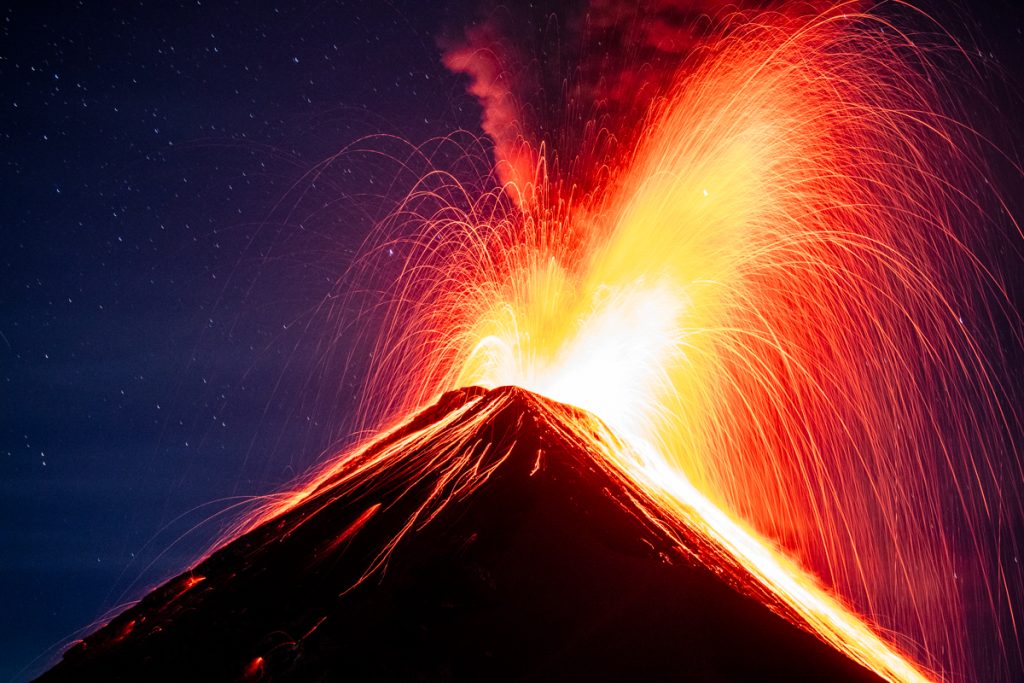
To shoot this volcano with the best possible view, he took his group to hike another volcano (this one, inactive, of course), called Acatenango, that gives you amazing views of Fuego, and in a very close position - they are aparted 2 km (6500 ft) away!
So, one important thing to know about volcanoes is that if they don’t make a lava river (like Fuego) you can’t see much during the day, unless a lot of smoke comes out of its mouth; the pictures of this huge column of plume are cool though.
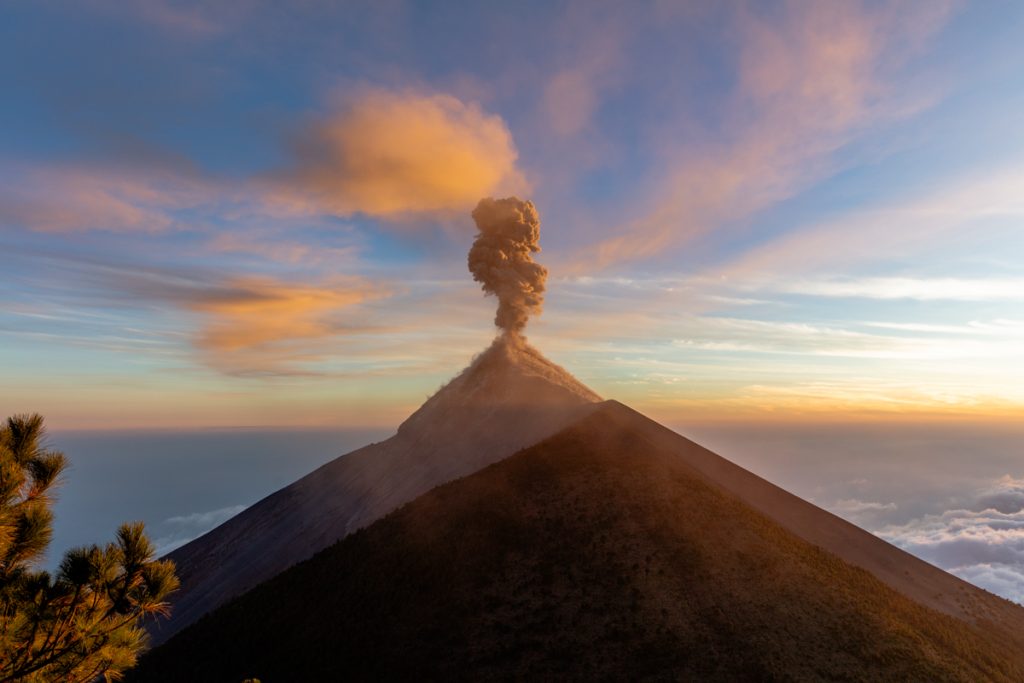
As there’s a lot of light illuminating the whole scene, you can make these pictures with the camera in hands, without a tripod (as long as you use a high shutter speed like 1/500 or more) which gives you more freedom to create different angled shots searching for an interesting foreground.
But, it’s at night that the real spectacle begins. Without the sunlight, the explosions of Fuego bring up amazing red lava, rocks flying and smoke. That’s when the really cool images starts to reveal, as long as you follow some basic tips:
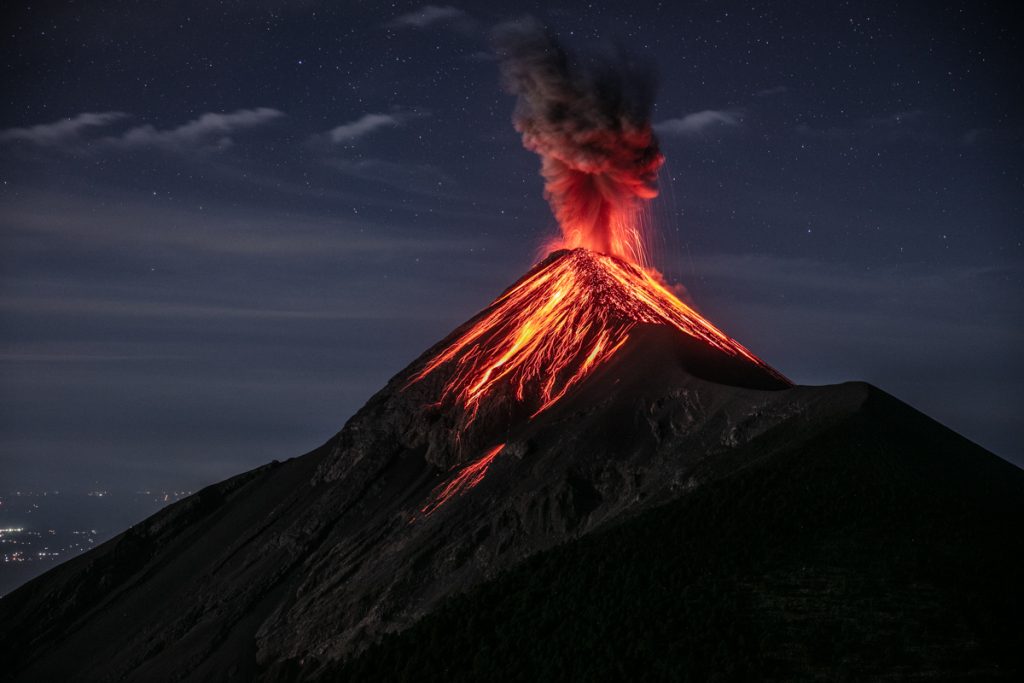
It’s really hard for any camera to autofocus in the dark, so rely on the manual focus, make it at any part of the volcano that you will be fine when the explosion occurs. Newer cameras like the mirrorless ones that have the live focus peaking feature are even easier to achieve the perfect manual focus. But, remember, if you change the lens or even change the focal length using the same lens, you will need to redo the manual focus.
In this experience we tried different focal lengths to have different shots every time Fuego gives his show. As we were really close from it, the longer length i used to frame the whole scene was 135mm, so a 70-200mm lens is more than enough to do the job. The results are impressive! On the other hand, if you want to make an image with the volcano plus the starry night sky (or with the long and tall smoke column) a wide angle focal length between 15 and 24 mm will work perfectly.
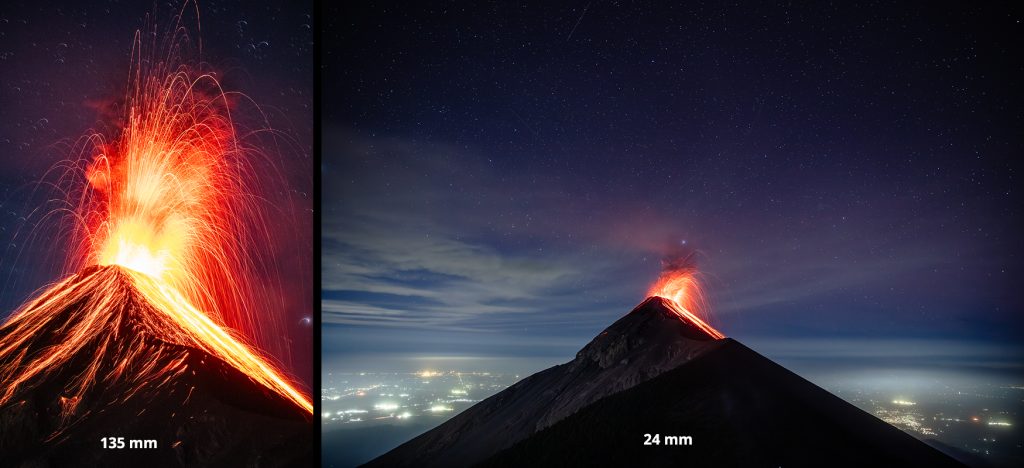
To make any active volcano pictures you will be around a lot of ash. Every explosion releases tons of ashes in the air, that falls within a radius of dozens or even thousands of kilometers. So my pick would be any f-stop with the Duradiamond exterior, to prevent ashes coming inside the backpack.
We spent the night at the base camp of Acatenango shooting Fuego, so you also need to bring warm clothes, gloves, water, some food, so think about a larger backpack than you usually use on your daily photo shoot sessions.
I used the Tilopa 50 during this trip and it was for sure the right choice not only because of its rugged exterior protection but also because it fits everything i needed for this adventure, including a 100-400mm lens that i used for closed shots of the volcano (i had this lens in Guatemala to shoot the quetzal bird, but that’s a story for another post! )
For any further questions, you can find Marcello on his instagram profile: https://www.instagram.com/marcellocavalcanti1/

Conor MacNeill, also known as the Fella, is a travel & landscape photographer. His biggest passions always was traveling and exploring which actually brought him to photography. Now he does both with a focus on landscapes, cityscapes, and sometimes astrophotography or even Deep Space.
Conor's philosophy extends beyond photography; he's also on a mission to greet every street dog he encounters, adding a heartwarming touch to his travels. Filmed at the Pro Hangout in North Macedonia, Conor reveals his minimalist approach to travel photography, showcasing how he navigates the globe with a compact, yet powerful photography kit.
After a trip in Kosovo Conor visited us at the Pro Hangout in North Macedonia and walked us through his travel kit



"I am not just here because of the photography and meeting everyone, I am also here to say hi to all the street dogs! "
His Tilopa houses only his Small Pro Insert with one Nikon Z9Body with a Battery grip and 2 Lenses, a Lens Hood, a Filter case, a Tripod, a few receipts, a memory card case, and clothes. Throughout his traveling and multiple packing occasions, he learned packing light tailored for him without compromising. Conscious decisions about what to bring is his blueprint. Think about what you really need.
Which one is more important to you specifically – weight or variety of gear?
In the past, Conor had multiple Batteries with him for his Camera. For these, he had also different compartments in his pack arranged so he could know which Batteries were full or which were used. By now he is only using his Camera with the Built-in Battery Grip which gives him enough Power supply throughout the day. At night he just plugs the Camera in with USB C and charges it like this.
This Workflow also allows him to save weight and space on Batteries, chargers, etc. He reduced it to the most needed items.
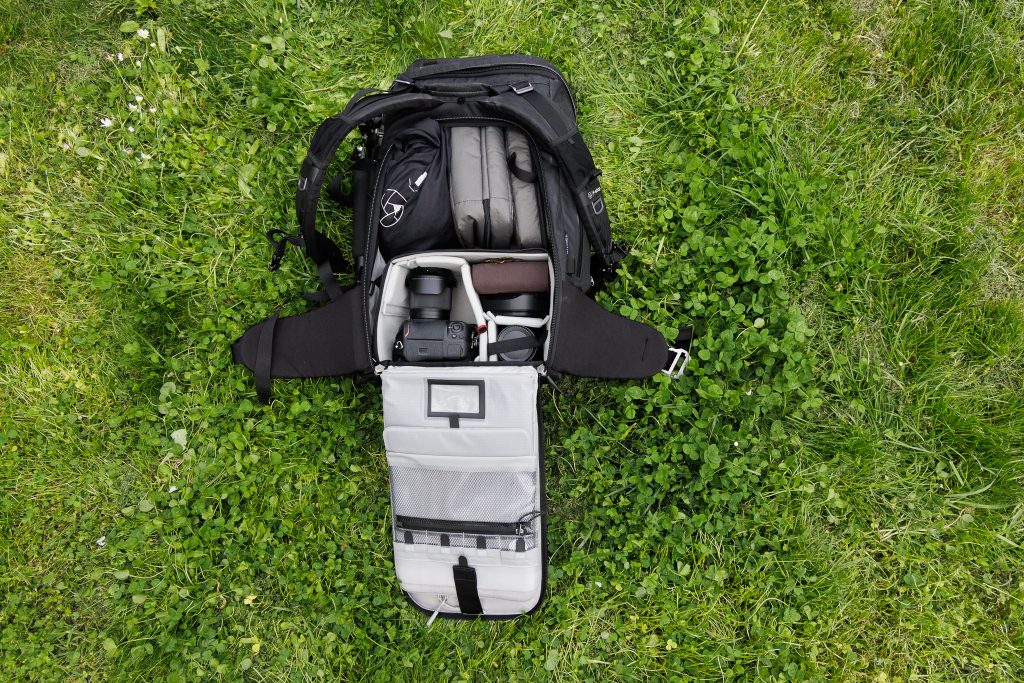
A look in his pack shows 4 parts of Cubes/pouches. Conor also repurposes some accessories like the dust cover as laundry bags in which the f-stop packs come shipped in, minimizing waste, and maximizing utility. He also gives the Accessory Pouches Large a different function to transport his clothing and keep it organized. Everyday items like socks, shirts, and undergarments are neatly packed away. The rest of his pack is very straightforward as well. Mesh pouches hold receipts and SIM cards or other items he needs when traveling for business while larger compartments hold his Gym Kit or a Jacket.
Heavier items, such as camera gear, at the bottom for optimal weight distribution. His laptop stays in the Laptop sleeve with an additional protective Case as well so he can take it out at airports and carry it around.




A well-padded laptop sleeve keeps my device secure, while a custom camera insert houses my essential photography equipment. Conor is selecting a compact kit tailored to my travel needs, including a large camera with a built-in grip and a versatile lens selection. USB-C charging capability further benefits my setup, reducing the need for multiple batteries. Having his items in different Compartments allows him to change, swap, and rearrange or similar quickly.

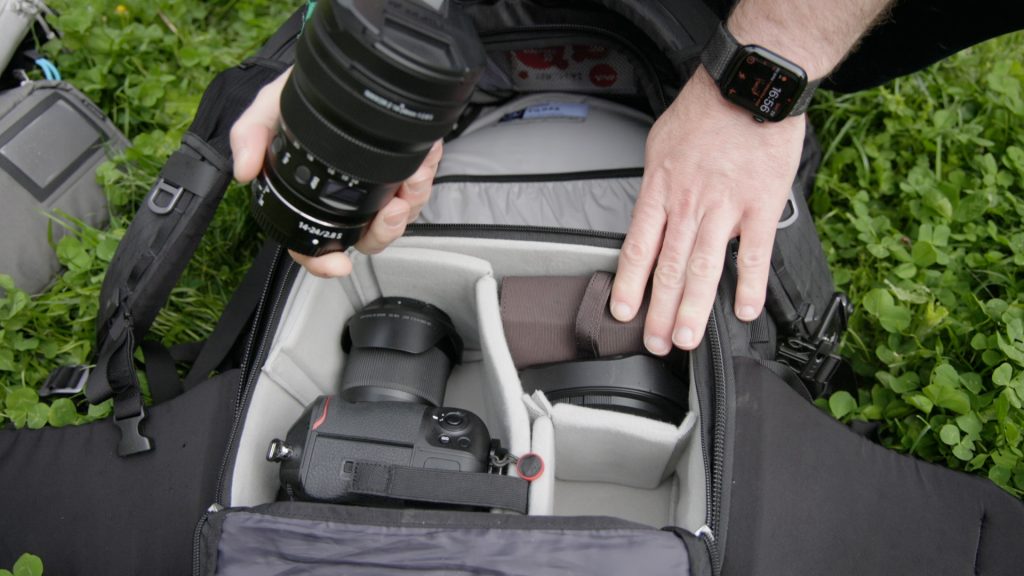
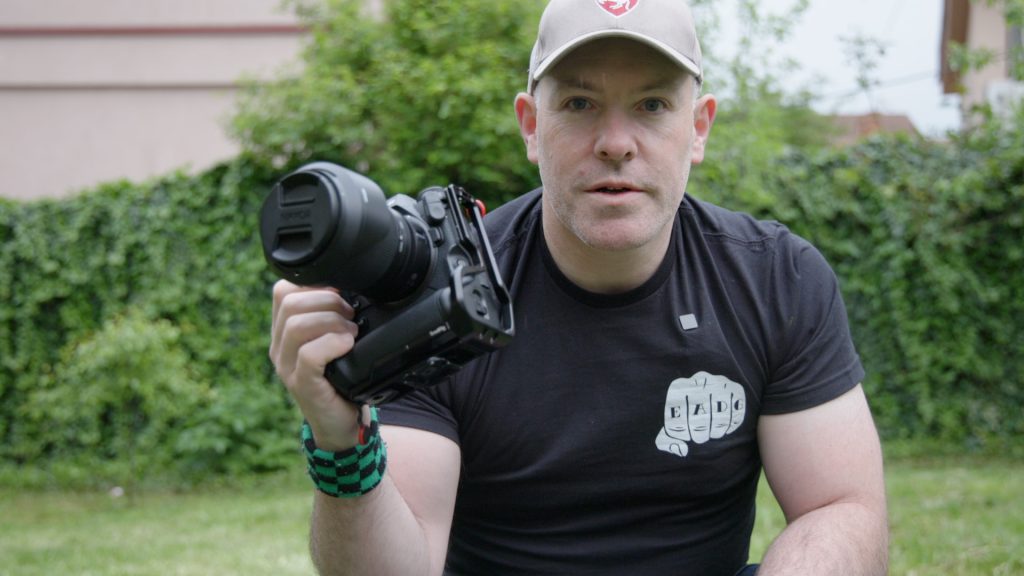
If Conor needs to take out the Camera Insert due to having to check in the Camera pack or he just needs to change it over in a different pack he folds up the flap of the insert, zips it up, and can carry it easily through the airport. Photos below show Conor with the Small Pro Camera Insert closed up - as he jokes with a camera Suitcase
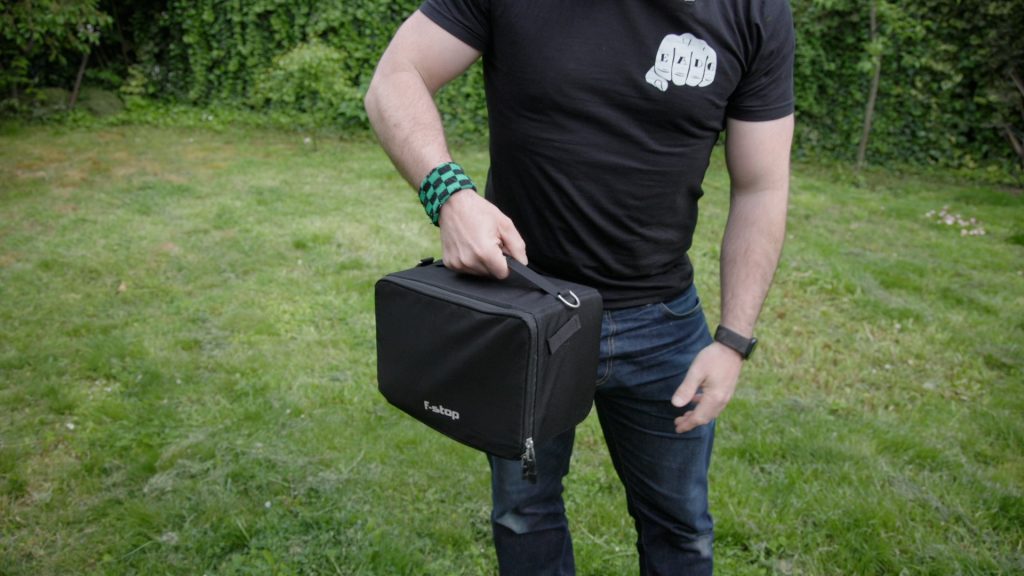

Handling tripods can be cumbersome, especially during travel. With Gatekeeper straps, he fastens the tripod to the outside of the bag. The Bottom Gatekeeper strap over all three keeps the legs secure and the Top strap through two legs to secure it from slipping down.



In case Conor is planning to travel with small planes he makes his packs look more compact by removing the ball head and placing both the Head and the Tripod in his Camera bag next to the Insert. The Tripod without the Ball head perfectly fits in his Tilopa from the Height still, so a conscious decision on a tripod height or being able to remove a ball head is part of his strategy. For him, this is ideal for navigating through airports or tight spaces.
“As a conscious traveler, I strive to minimize waste and maximize utility. Making conscious choices that can enhance my travel experience!”
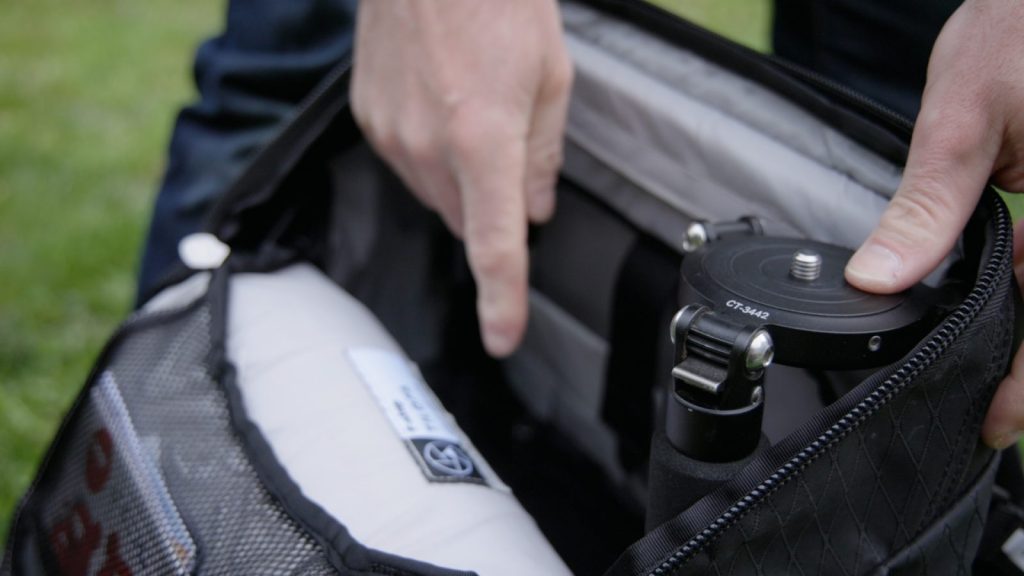
Connect with Conor : https://thefella.com
Nick's gear bag opens to reveal the main compartment, carefully organized to accommodate his primary camera system. His packing reflect Nick's commitment to professionalism and preparedness, vital qualities for any serious photographer or filmmaker.
...but as a vital component of a professional workflow.
With a nod to the unpredictability of industry Nick’s bag is not just a collection of gear; it is his safety net, ensuring that no matter the circumstances, he can always deliver.
Nick relies on a range of gear depending on the project at hand. For smaller jobs, he opts for Nikon gear, keeping the load light and efficient. However, for larger shoots, he needs to utilize a mix of equipment, including drones, gimbals, and multiple camera bodies, such as RED cameras.
He takes advantage of the modular setup, utilizing interchangeable camera inserts (ICUs) often also pre-packed for specific applications. This allows for quick transitions between different types of shoots in between different packs. On the other side, he also stores the gear in the Camera insert at home in the Camera Units and just shoves in the pack what he needs.
"For me, it is the best way of keeping my gear organized when I'm not traveling. I just have things stored in Inserts at home like this, also ready to be put in a pack."
One of the most draining tasks next to shooting is to carry all you need with you from place to place. Arriving tired on set or just getting worn out throughout the day are two things Nick tries to prevent as best he can.
All the f-stop packs have a "comfort weight" as we call it and recommendations for carrying gear safely and comfortably, but what if you just need more?
Weight from not only the camera gear but also batteries, cables, hard drives, computer, and accessories quickly adds up. Nick has a high tolerance for the weight he can carry – so his comfort weight may not be the same as for someone else of the same build. A lot of factors come in here like condition, muscles, resilience, etc. Some say Nick is a packhorse when it comes to carrying gear - We call that dedication!
The first thing he does is to make sure he selects the right pack for the right needs. Every pack is purpose-built, and the f-stop pack up from 50 L has thicker padding to provide more carry comfort for heavier packs, longer trips, etc. His go-to pack is the Tilopa 50 L due to the compact weight distribution which allows him to carry everything as close to his weight center as possible. If he would need more room, he takes the Shinn 80 L.
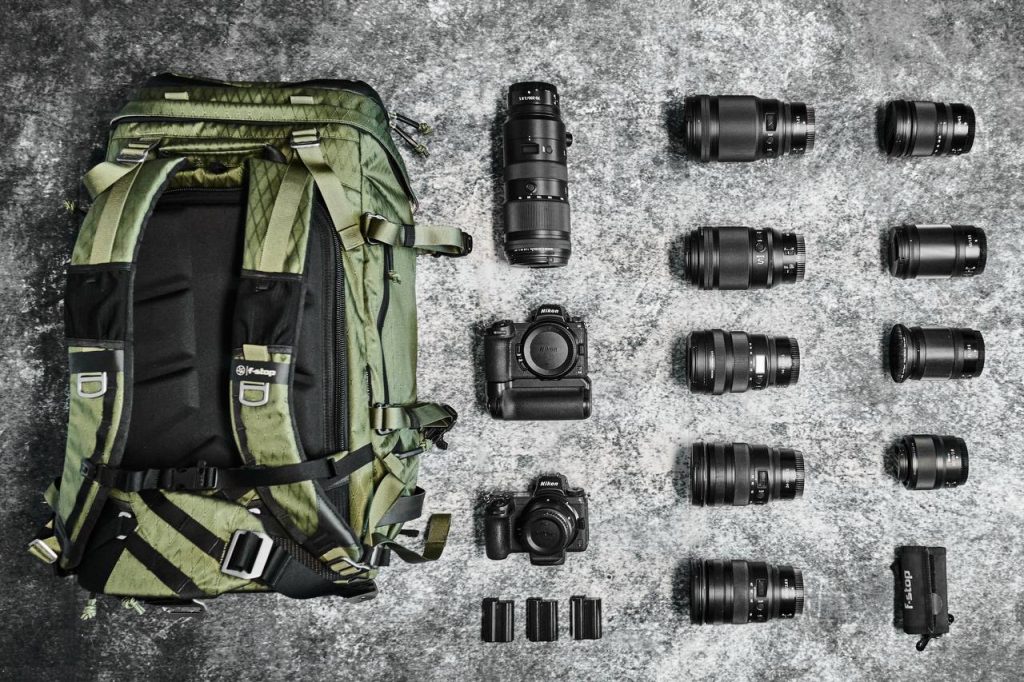
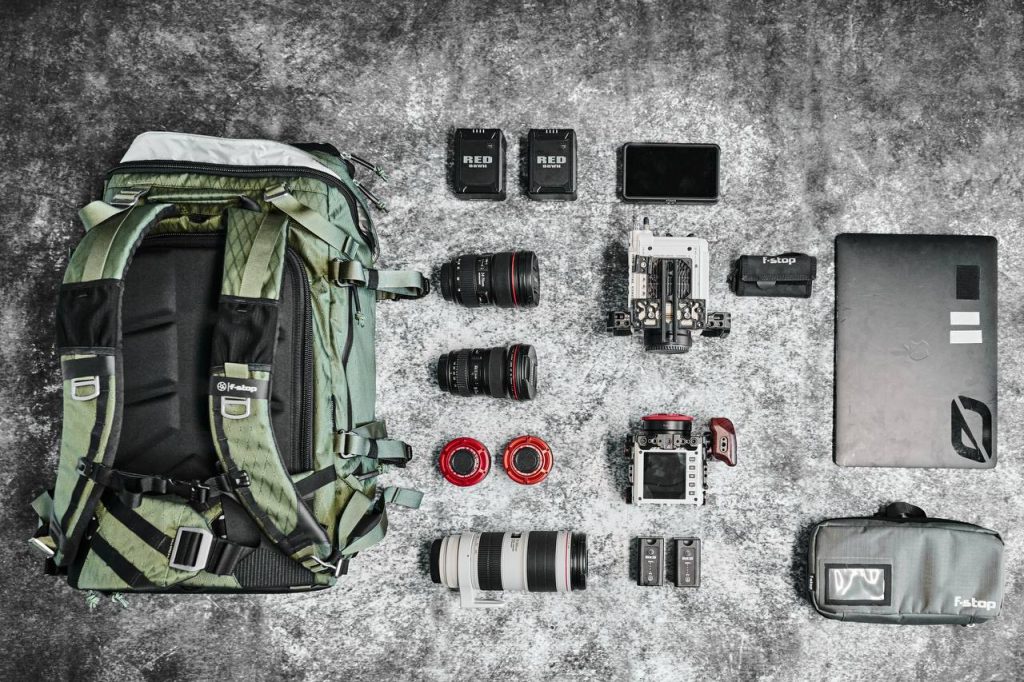
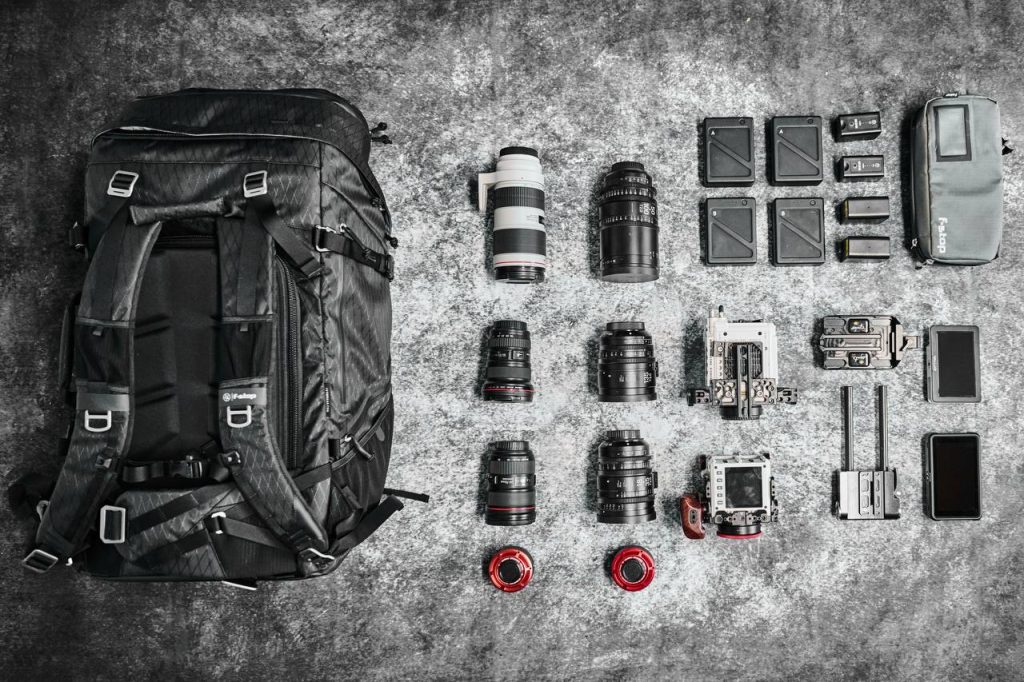
Central to Nick’s workflow is the organization of his gear.
When packing, he rather takes the time he needs than pack in a rush. It needs to fit and fulfill his needs so smart arrangements will save him time, having to repack, and avoid any frustrations. When packing the Inserts for specific jobs, he just takes all dividers out and rearranges gear how it fits best.
Another big focus when arranging his gear is distributing the weight as evenly as possible and ensuring easy and fast access to essential items.
"I've always taken the approach that I can work harder and carry more as long as it's going to give me the best results. But I need to balance that with not being tired and wearing myself out or being slow. I need to be able to be agile. I need to have the gear that I need and not take too much whilst also having enough that I'm not left lacking."
Be creative Arrange the gear in how it works best for you specifically.
“I've been packing these bags for some time, and I find that the more creative I am and the more I allow myself to experiment and take my time instead of rushing, the better the outcome. Having redundancy in gear, even if it makes the pack slightly heavier, is far more important to me than the weight of my pack alone. Obviously, carrying weight safely is crucial, which is why I ensure everything is secured at the bottom. But as long as I'm packing safely and taking care of myself, avoiding arriving on set tired, I find it to be incredibly valuable.”
Nick Leavesley
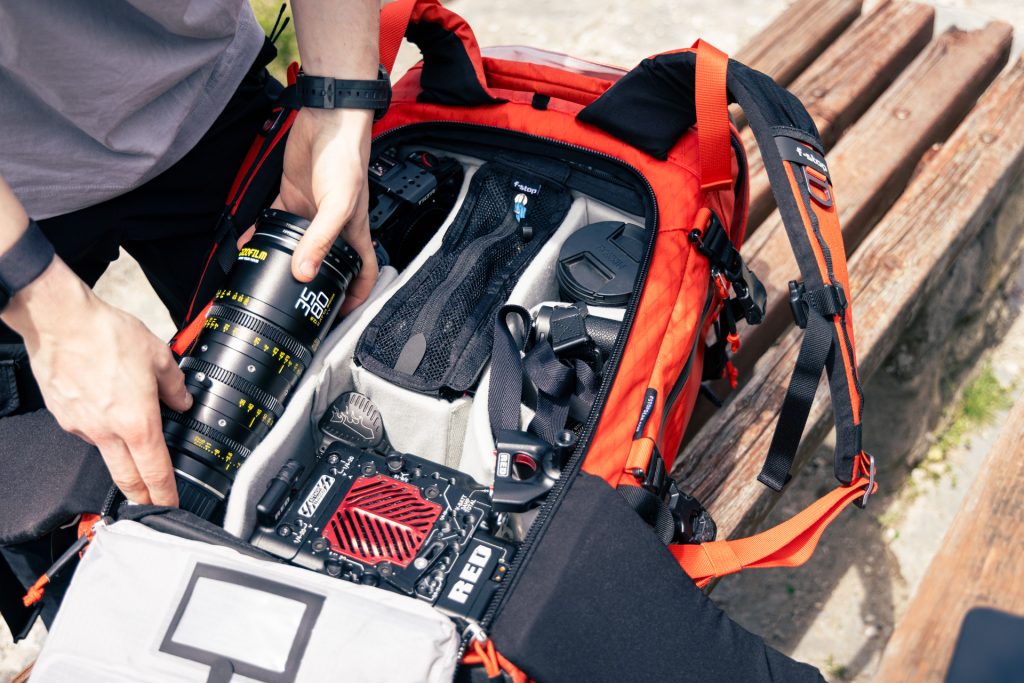
At the center lies his workhorse camera, a state-of-the-art RED model paired with two more Camera Bodies and lenses alongside a drone in this setup. He makes sure he is equipped to tackle any photographic challenge and be flexible and versatile for whatever he gets his teeth hooked in. To complement his RED setup, Nick also includes a compact DSLR as a backup camera, ensuring redundancy in case of equipment failure or unexpected contingencies.
Heavy equipment like the RED Brain camera, together with the V-Log and also the monitor adaptor for the RED 7-inch touch screen, is placed at the bottom to prevent any long-term warping of the camera insert and maintain balance during transport. He finds it's nice to be able to just put it pre-assembled straight in the bag. It saves me from having to assemble everything.
Nick is all about adaptability and preparedness. Through investment in versatile gear and a flexible organizational system, he avoids stress and saves time, so he can handle a broad spectrum of projects. Every aspect of his setup is designed to maximize efficiency and creativity in the field. Not needing to worry about where things are or having to repack his pack to stay organized is highly valuable for him and keeps him focused on what in front of him.
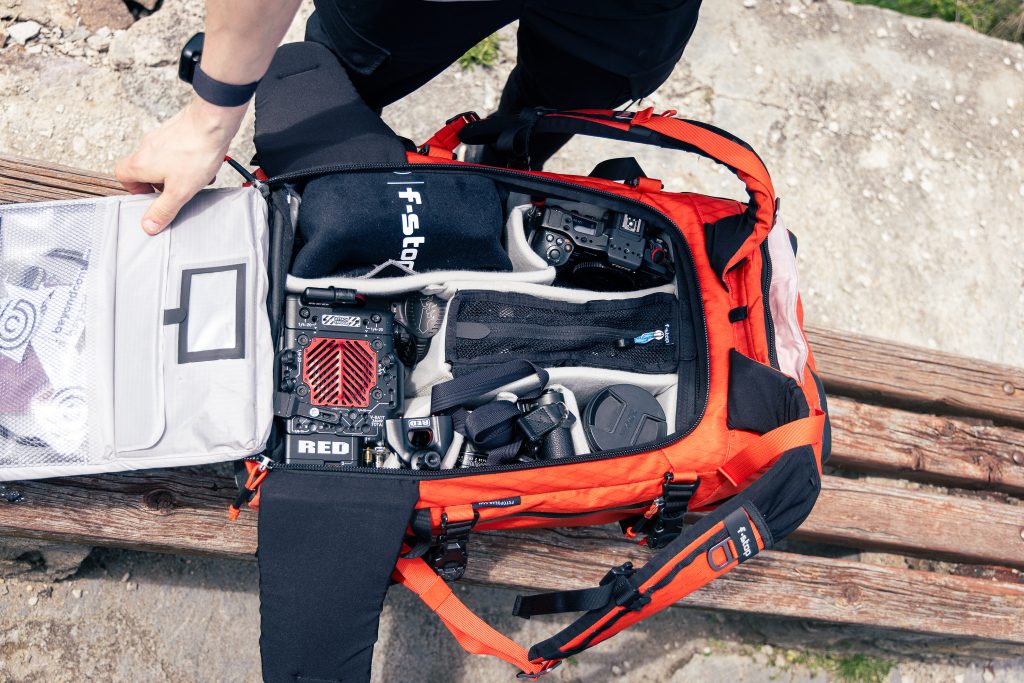
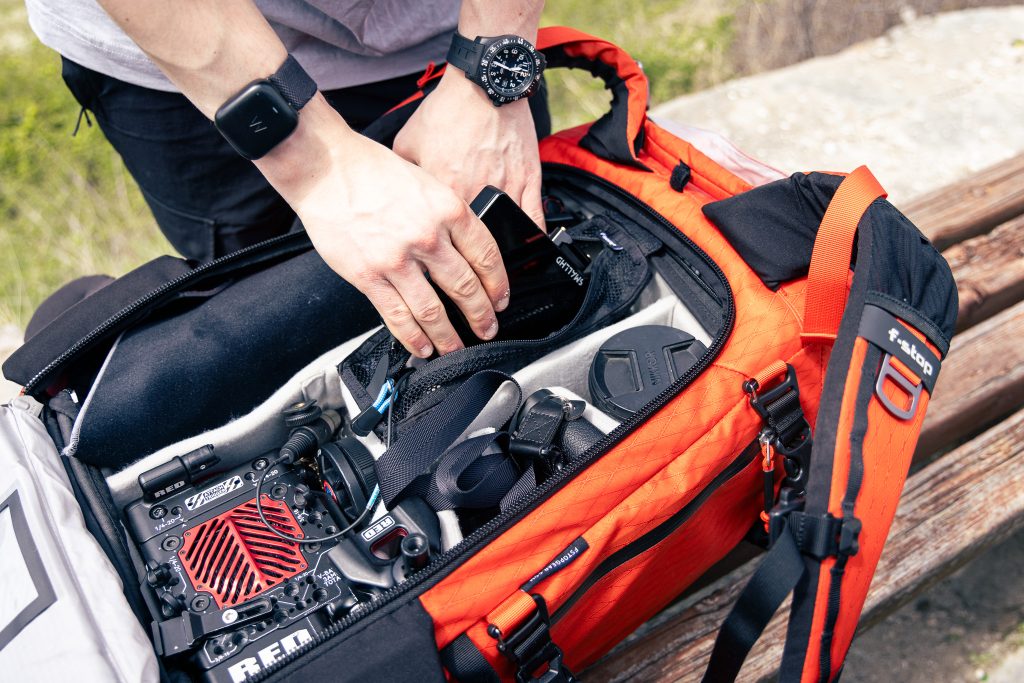
Items such as a drone (DJI Mavic 3 Pro or DJI Air 2), lenses, sound equipment, and accessories are strategically positioned for convenience and efficiency. He carries the Drone in a Protective wrap and due to the depth of the Insert can place another Lens stacked on top (in this case a 200 mm)
Adjacent to the main camera setup, Nick's gear bag houses an array of essential accessories He brings small accessories and cables in dedicated pouches and compartments to prevent loss and ensure easy access.
A robust V-lock battery pack ensures uninterrupted power supply throughout long shooting sessions, while a specially designed adaptor allows seamless integration of a seven-inch touchscreen monitor, enhancing monitoring and playback capabilities on set. Nick's dedication to detail extends to the placement of smaller accessories such as backup cables, chargers, and adapter plates for quick retrieval when needed. This organization not only maximizes efficiency during shoots but also minimizes the risk of misplacing or losing valuable equipment in the field.
He also always carries a variety of Gatekeeper Straps, allowing him to attach miscellaneous items outside the pack. Sometimes, he attaches a lens (in a case), a tripod, ropes, etc. One or two small carabiners are always found hooked in the gatekeeper attachment points.
"You never know when you're going to want to clip something to your bag, whether that's a water bottle or just a random kind of bag or something that needs to be carried. Sometimes I also use these gatekeepers to carry longer lenses, so if I'm doing any telephoto stuff, these will be perfect. I always go overkill on how many gatekeepers I need because on shoots, I often change this setup live. It's nice to be able to have the flexibility and plenty of gatekeepers to do that.
At the top of Nick's gear bag lies his mobile editing workstation. Nick always tries to bring a powerful laptop at all times. Currently, he is using the 16-inch M1 MacBook Pro.
In a dedicated compartment within his gear bag, Nick stores a variety of hard drives and memory cards essential for data management and backup. Portable SSDs provide redundant storage solutions, safeguarding project files against loss or corruption. Spare cables are readily available for connectivity and data transfer. Data management remains a top priority, with redundant storage solutions and backup drives ensuring critical files are consistently safeguarded.

“I try and tailor my workflow around USB-C. I think it's a great format and allows a lot of flexibility and all of the computers I use can take USB-C. But I do need to make sure that I have cables in place so that if a client doesn't, I can give them a USB cable.
To store data securely and have all necessary resources at your disposal. At the end of the day, clients are paying a lot of money. He therefore maintains a few in-progress hard drives and hot spares ready, just in case of failures or the need for backups. When working in a team or with multiple bags Nick makes it a practice to distribute a project across two bags, mitigating the risk of total loss due to damage or if someone loses a bag. In challenging shooting environments stress levels can be high and distractions frequent. So you need to calculate this in.
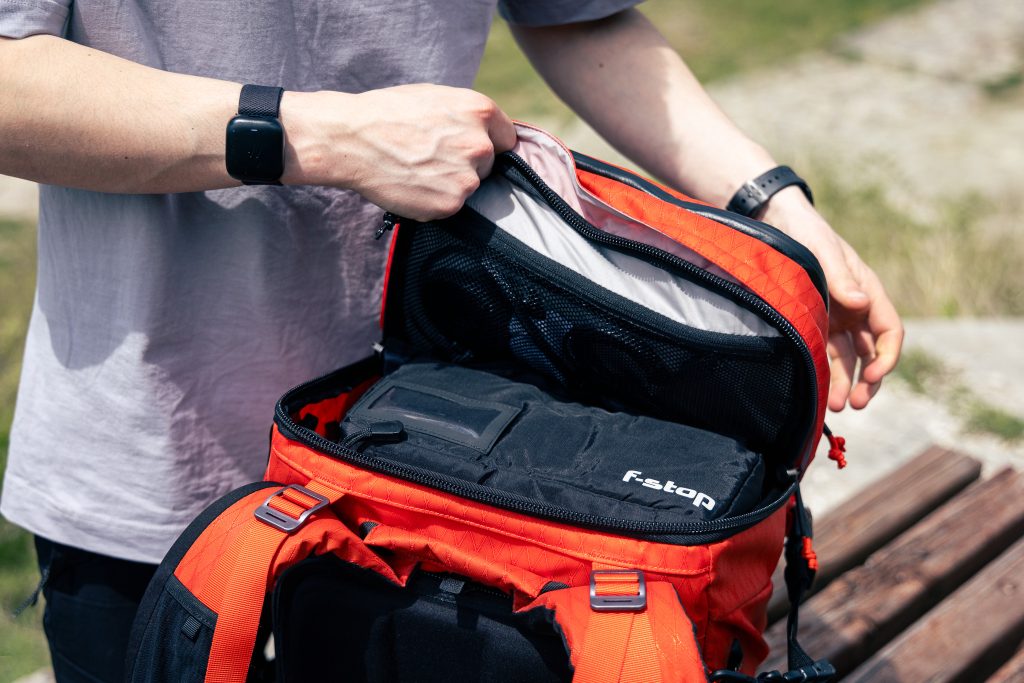
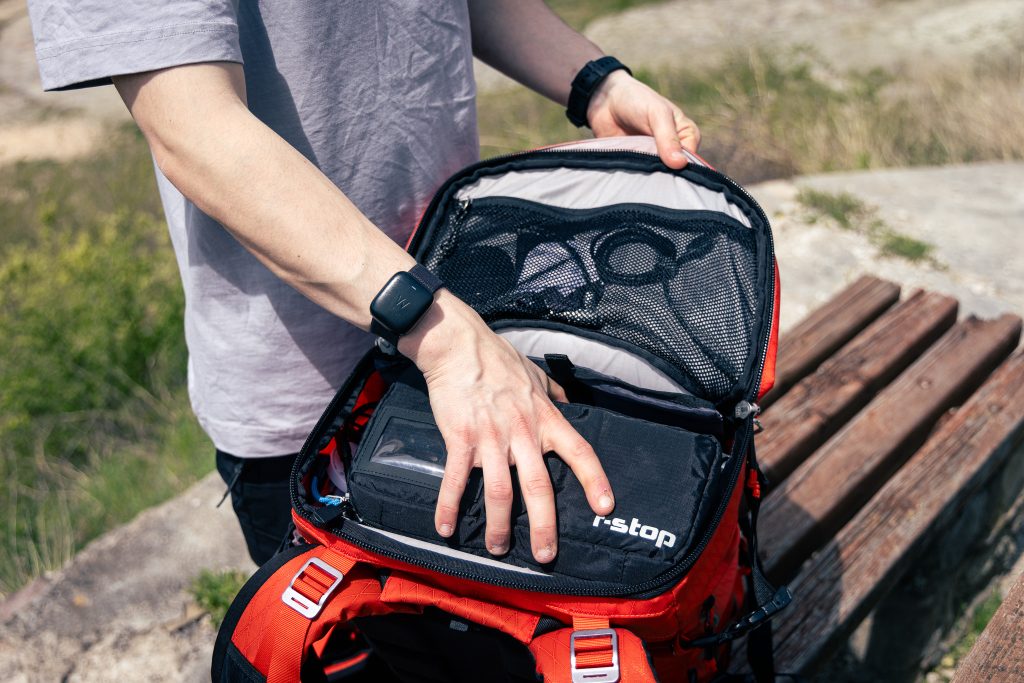
“Given my frequent juggling of multiple projects, the ability to store five or six projects simultaneously is essential. This is particularly vital when working with RED cameras. TB quickly add up!”
In addition to video, Nick also captures stills, organizing hard drives by year or project. These drives contain not only the images but also the Lightroom catalogs. He maintains a separate directory for RAW files from Capture One at the top of each drive. Additionally, Nick always packs a few backup micro SD cards, which are easy to overlook but essential. For instances where a client needs a quick photo directly from the camera or a device, I ensure an SD card to lightning cable is on hand for immediate file transfer, facilitating instant sharing of quality images.
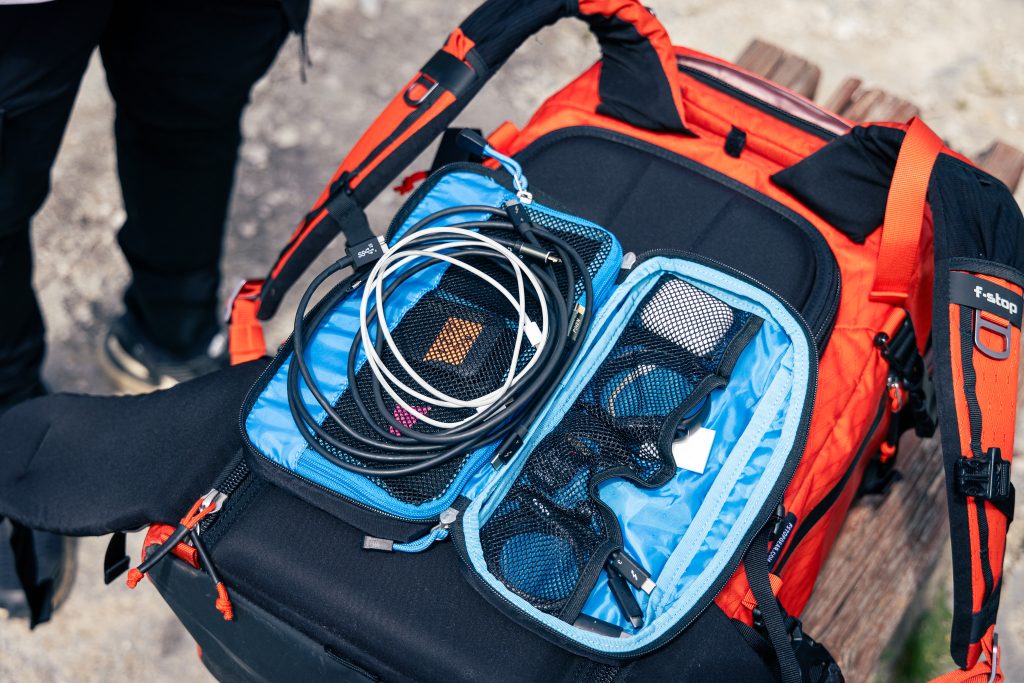
The importance of having all data backed up and securely stored can not be overstated. Losing data is not an option; thus, whether through cloud backups or multiple hard drives, safeguarding data is imperative.
The front pocket! This is one of my favorite parts of the Tilopa because it allows me to store my batteries in a very efficient way, especially the V-mounts. It's deep enough that I can store two of them stacked sideways, effectively fitting almost double the number of batteries in this space. At home, I might even have up to eight V-mounts neatly packed in this top section.
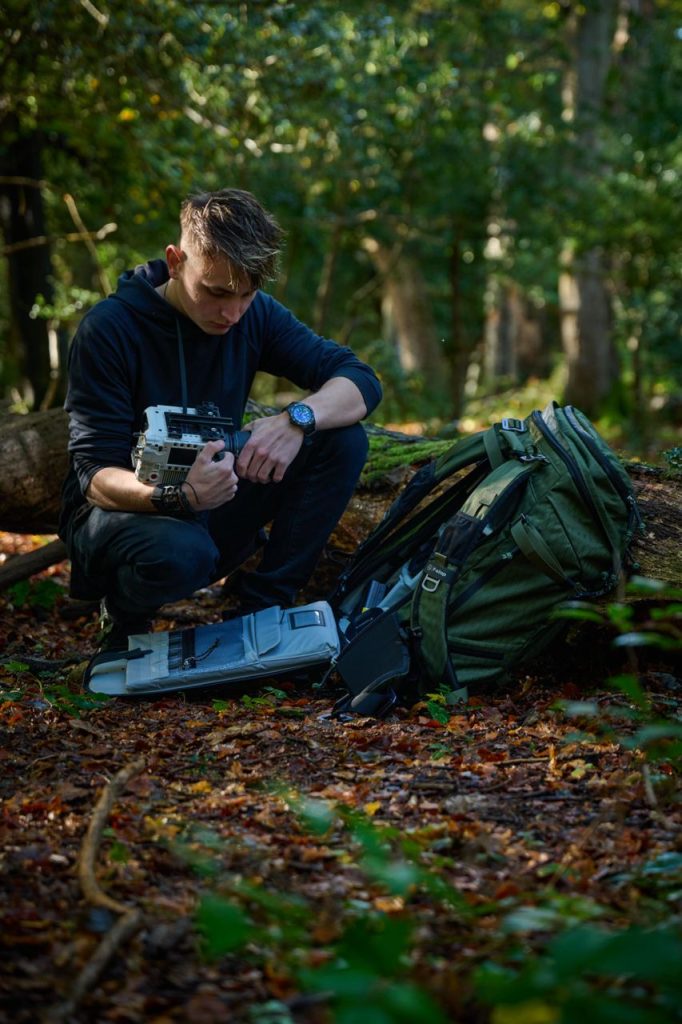
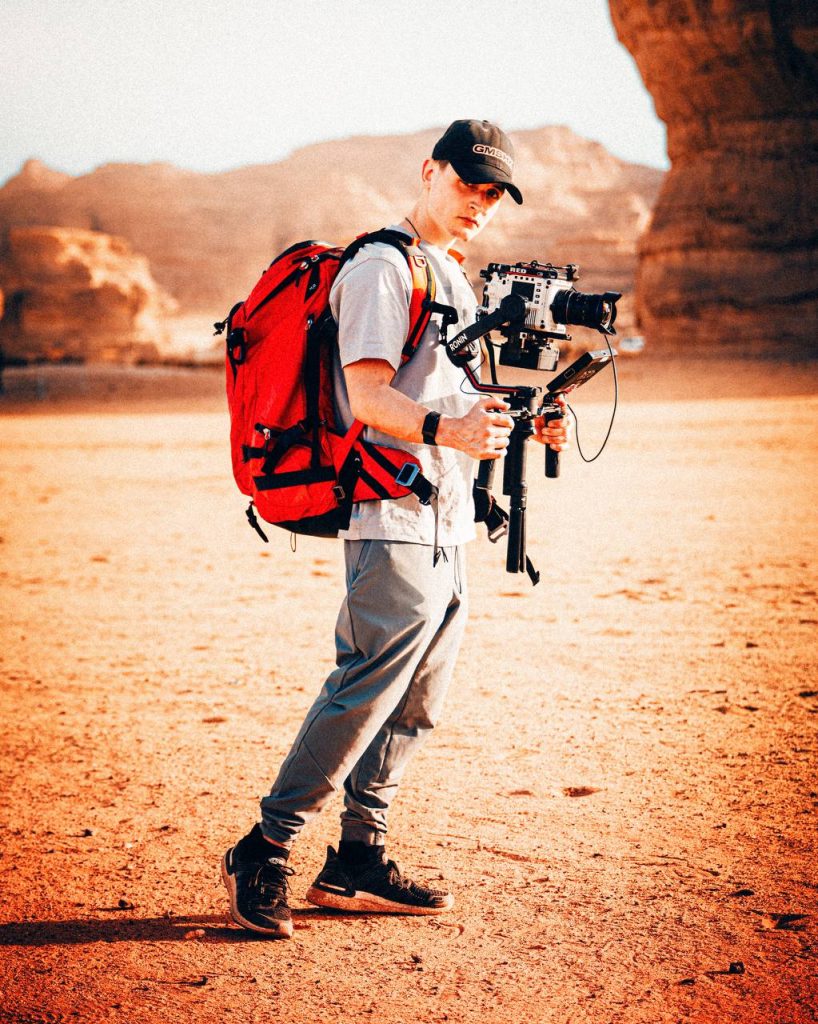
Connect with Nick . https://www.instagram.com/beyondnick/
In outdoor sports photography, being prepared is not just about skill, creativity and having the right gear. It's also as much about your level of organization and how you pack. Join us as we explore the world of Pro Photographer and f-stop Ambassador Frien Harald Wisthaler, as he navigates the demanding and exhilarating world of the Ski-Cross World Cup in Ineichen.
Nestled in the Dolomites, Harald's home in Italy (South Tyrol) offers the perfect canvas for his 15-year photographic journey. His latest challenge? Only capturing the high-speed action and raw emotion at the Ski-Cross World Cup.
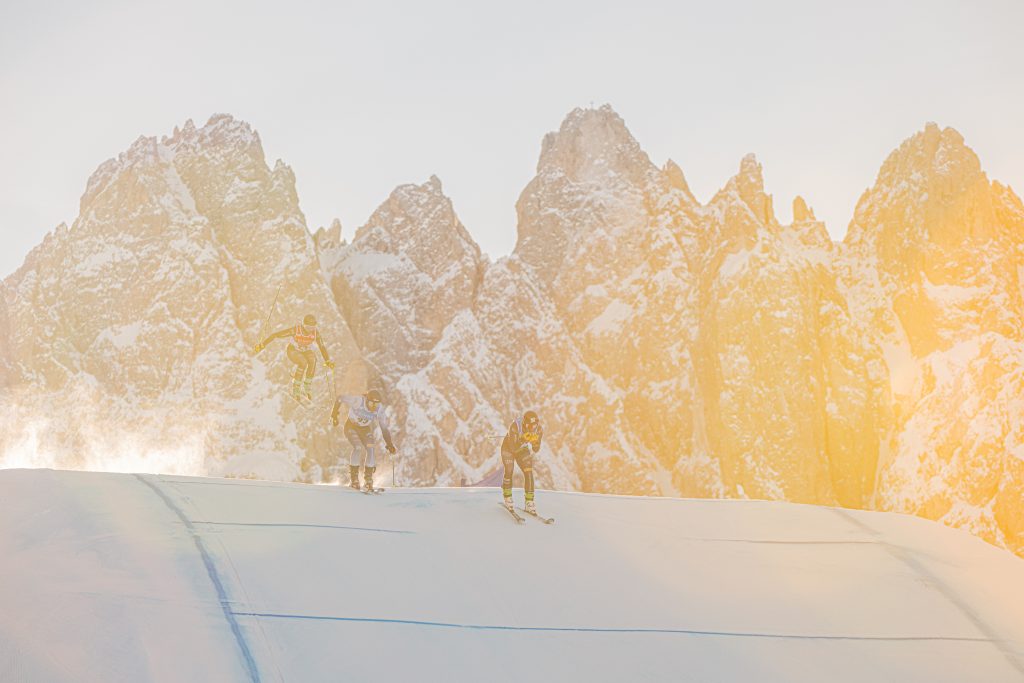
The Gear:
The toolkit at Harald's disposal is as diverse as the sport itself. With his Mirrorless Nikon camera bodies, his range of lenses from wide-angle to super telephoto lens sets, alongside protective gear and outdoor wear, he geared up for a vast range of shooting situations. But it's not just about having the right gear; it's about knowing how to pack it. Harald emphasizes the importance of being consistently organized, but also flexible, often changing the equipment he packs based on the day's conditions and location scouting insights.
Proper Preparation: Harald told us that his number 1 tip is to not only make yourself familiar with your camera and lenses but also get to know the features of your bags. Look at all pockets and ask yourself why these are there and for what scenario you can use them for yourself! Make the gear yours and really get to know the equipment you're working with. This will help you work smarter and faster in almost every aspect when you're in the field and will make dealing with issues and obstacles a breeze.
OV German - Turn on the Captions for English translation
In the fast-paced world of sports photography, being prepared and flexible is just as important as having a keen eye for the shot. At the Ski-Cross World-cup, Harald faces unique challenges. His Office is situated just next to the ski slope, which for him has its pros and cons: He is always right in the middle of everything, no matter what.
To shoot an event like this effectively, you must always be ready to go, constantly aware of the schedules and factoring in the time you need to get up and down the slopes; and of course, adjust to the weather. When the race starts, everything is finished in 50 minutes. Choosing the right spot to bed in is crucial. Getting the shots you need requires strategic planning and sometimes a bit of luck. You need to be aware that moving positions during races is often not feasible and you cannot cross the race areas, so choose your position based on your goals.
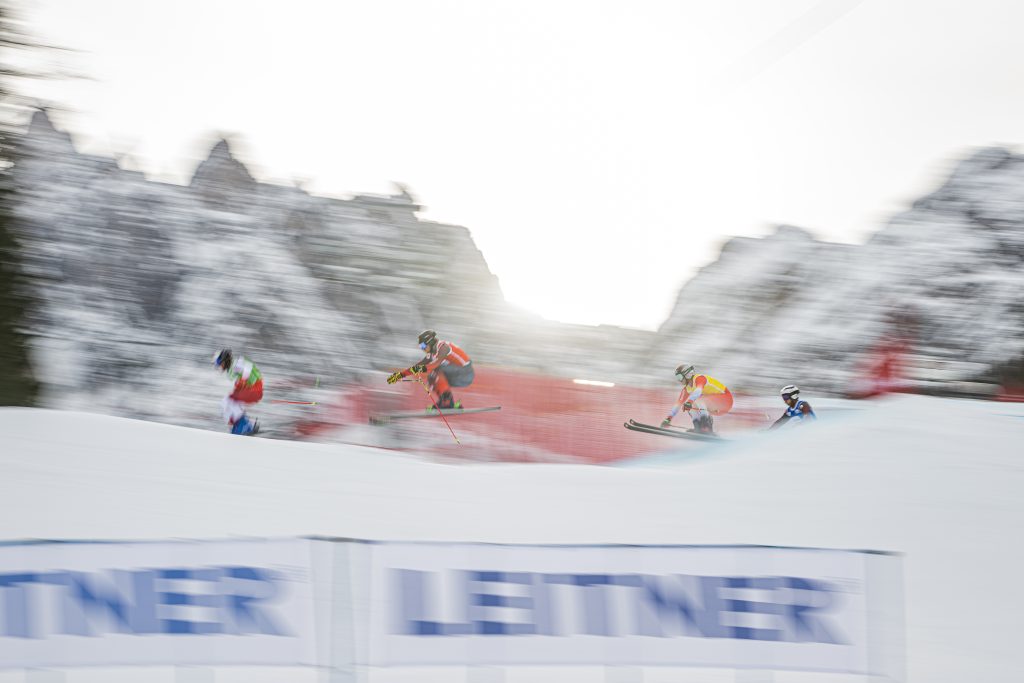
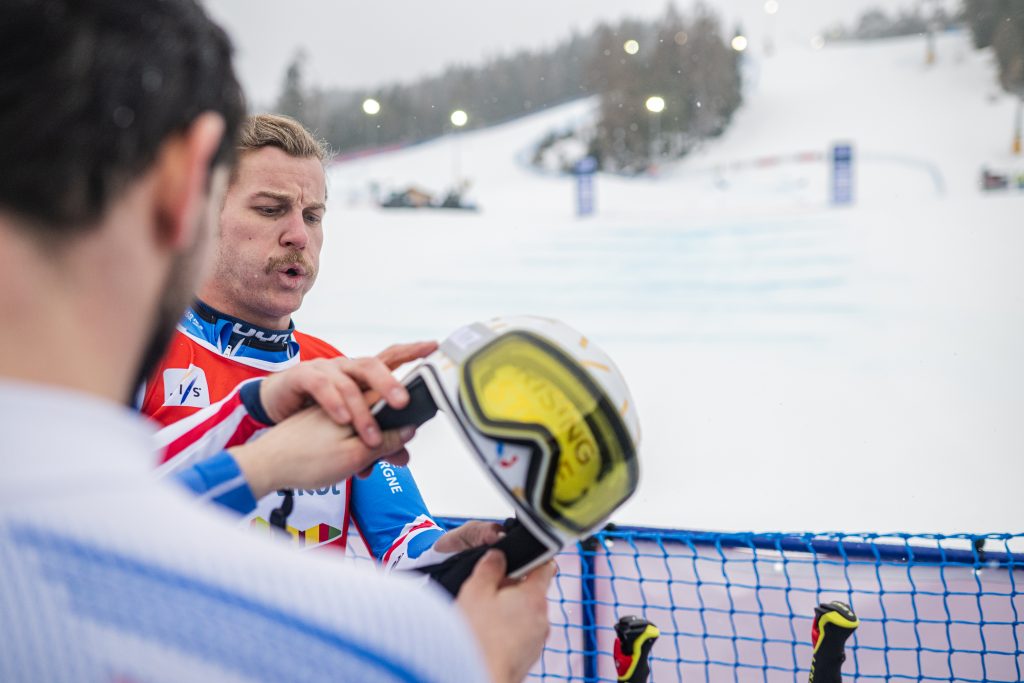
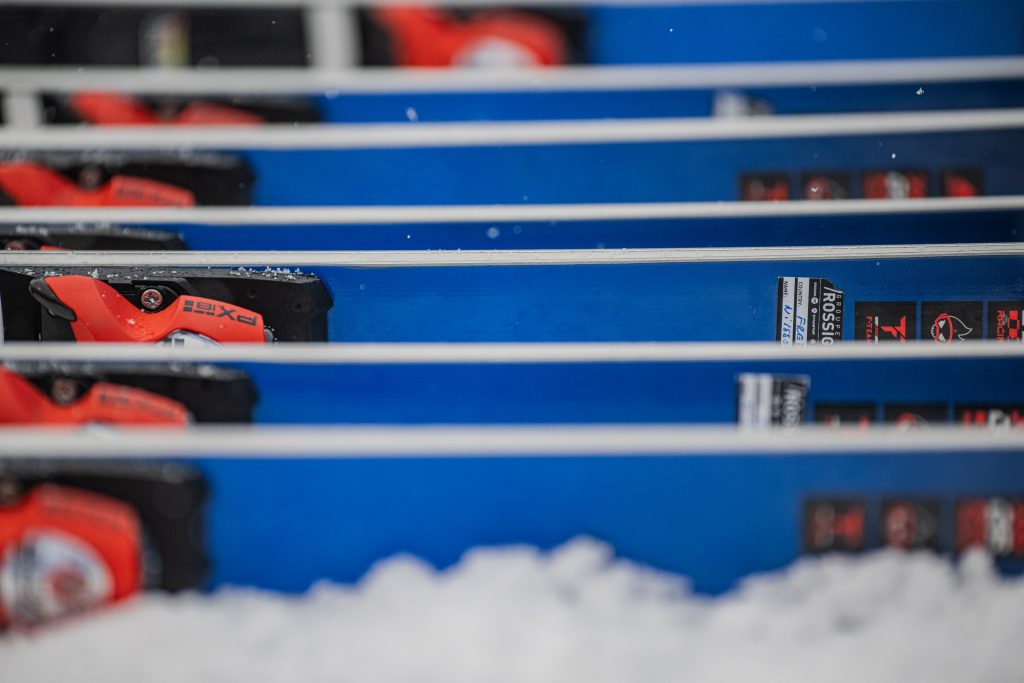
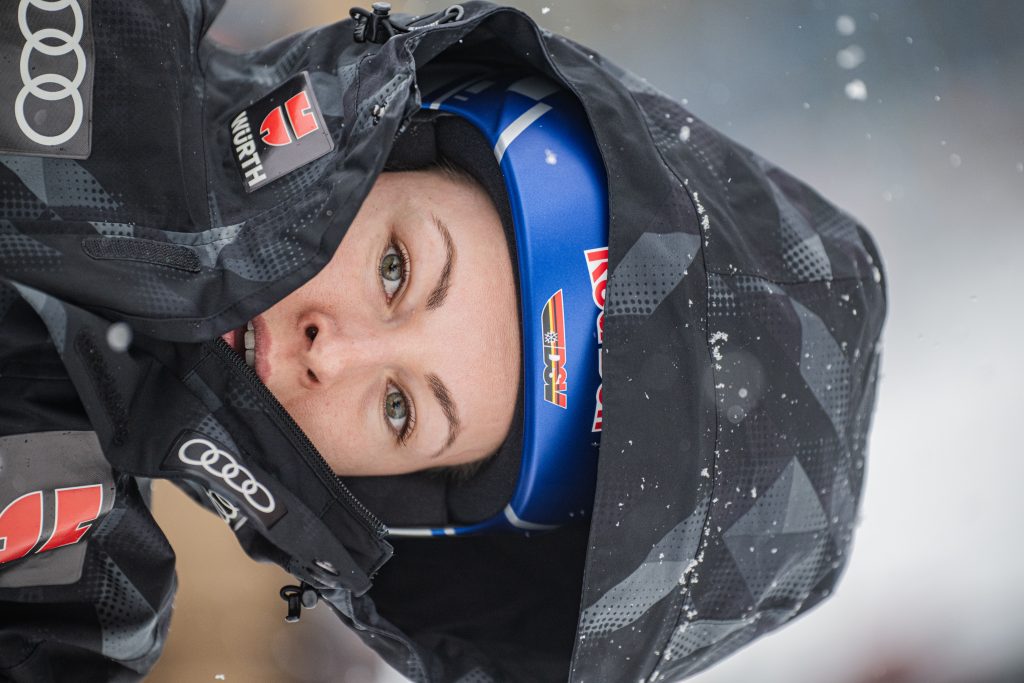
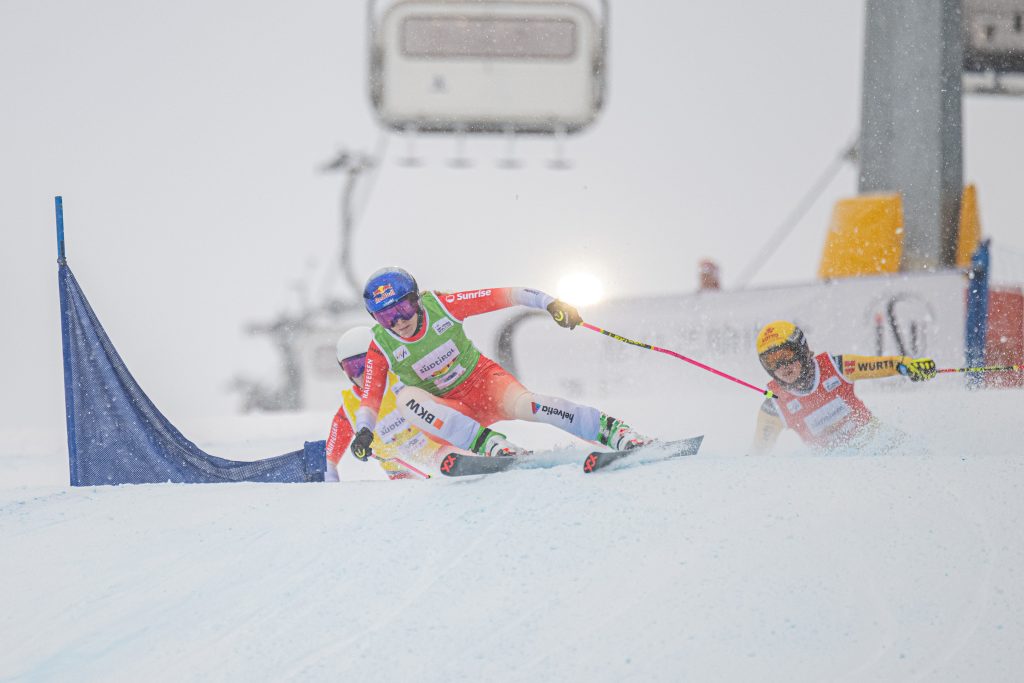
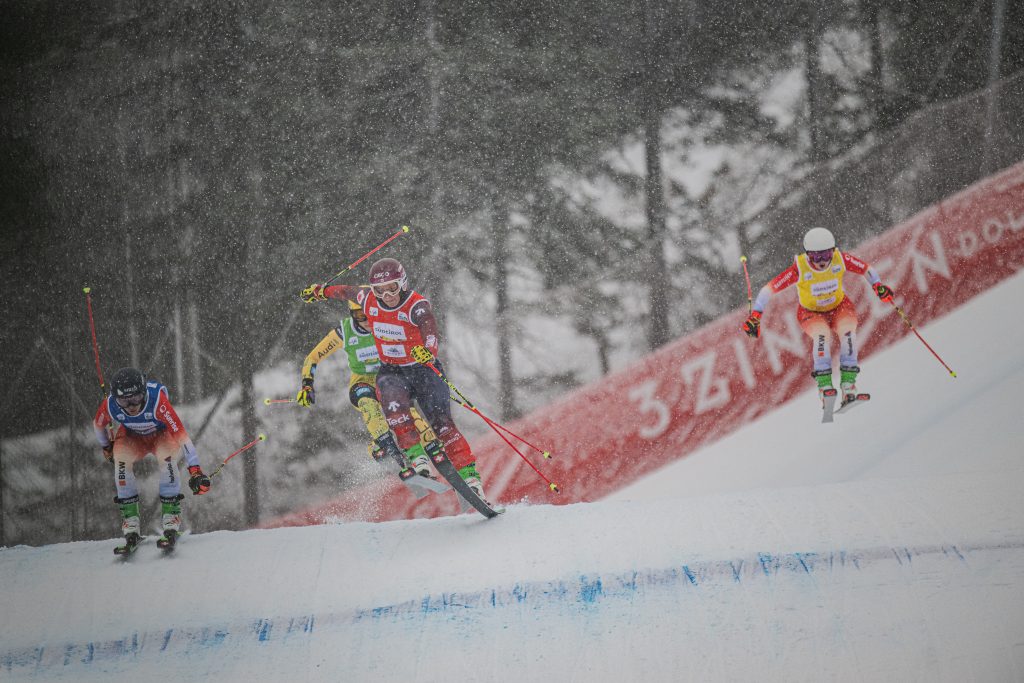
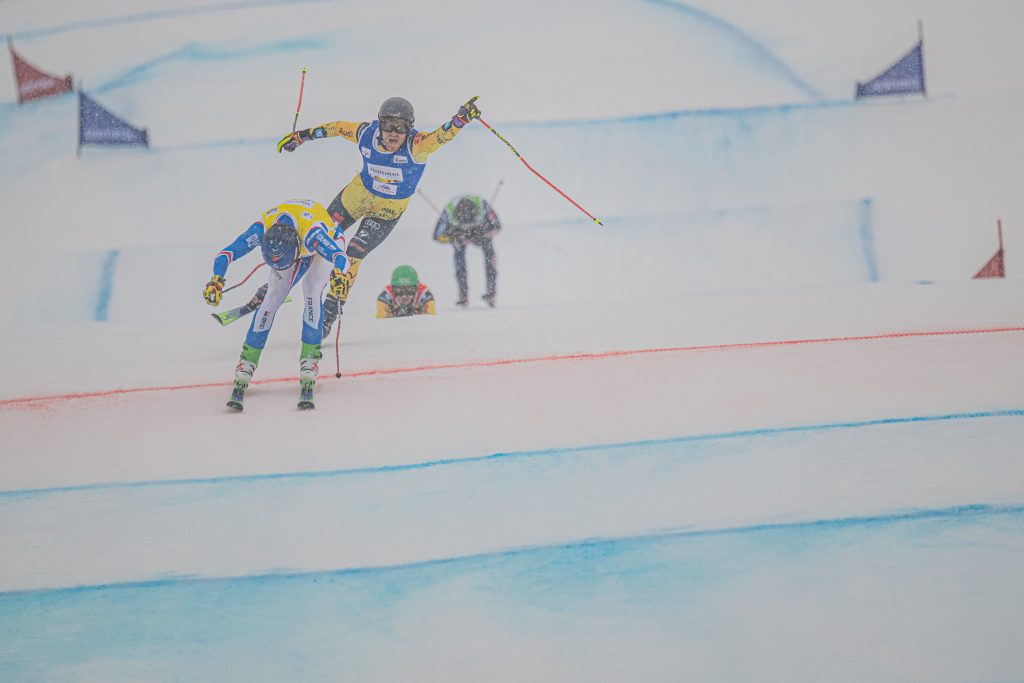
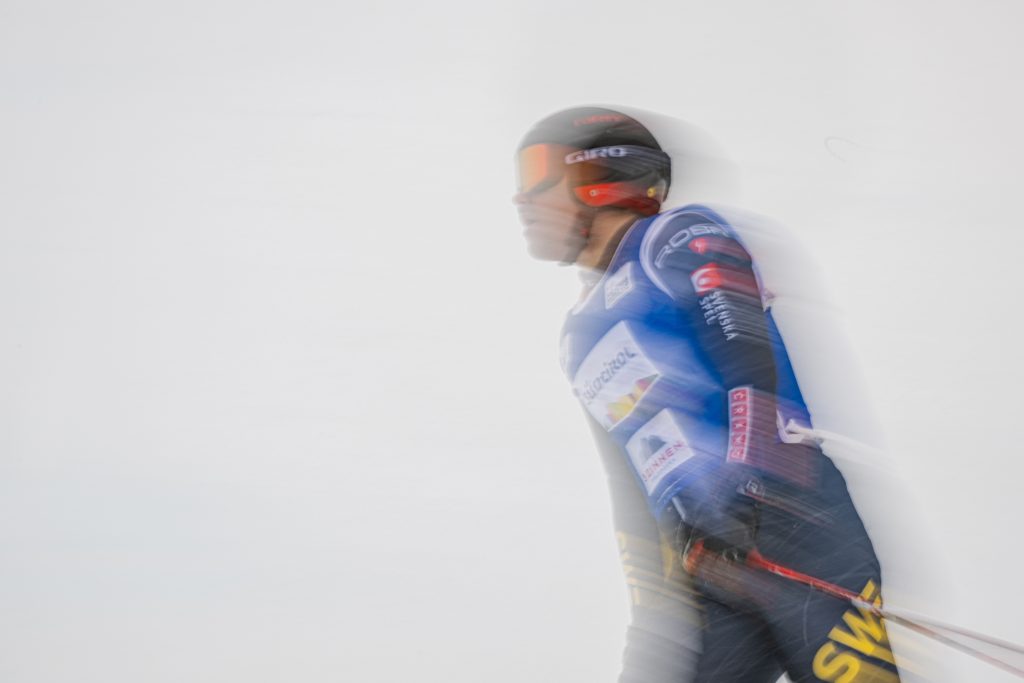
Harald's passion for photography stems from far more than simply clicking the shutter. The journey to each shoot is just as important to him. Whether it's World Cup events or serene mountain vistas, Harald knows that each adventure starts with a well-packed bag. Harald swears by his f-stop Tilopa DuraDiamond® 50l pack, a reliable companion on all his escapades.
The key, he says, is consistency and preparedness. He packs the same way every time depending on the situation, ensuring he can find everything in a flash - be it his trusty 50mm lens or a crucial first aid kit. By keeping his pack consistently organized, ensuring he can quickly grab the right lens for the shot without a second thought. His advice? Keep your setup routine and familiar, so you're always ready, regardless of the conditions or the rush.
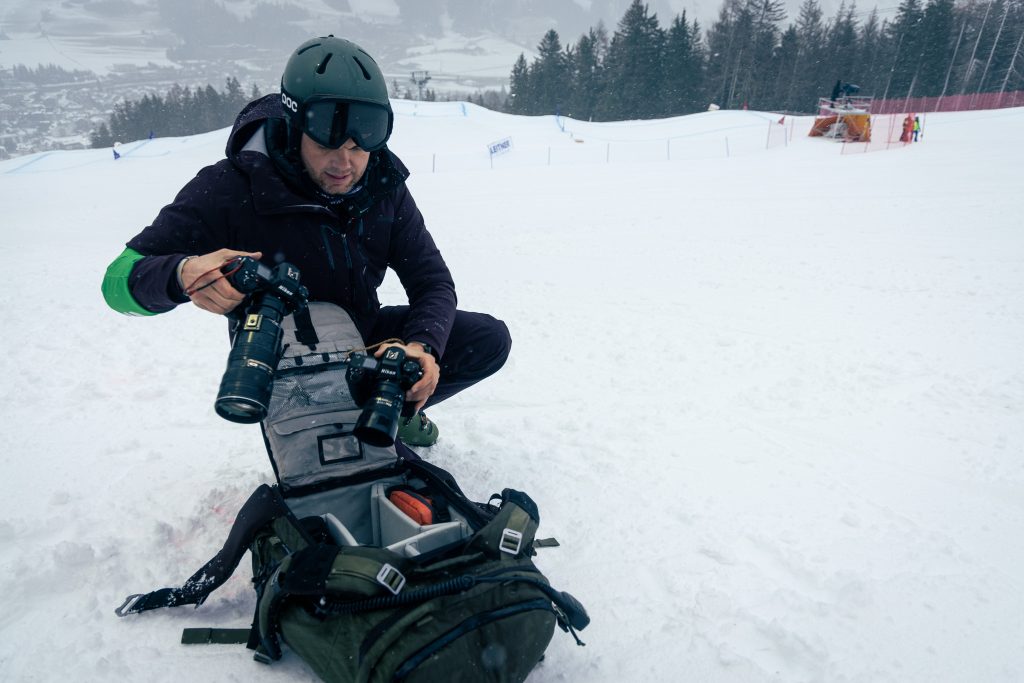
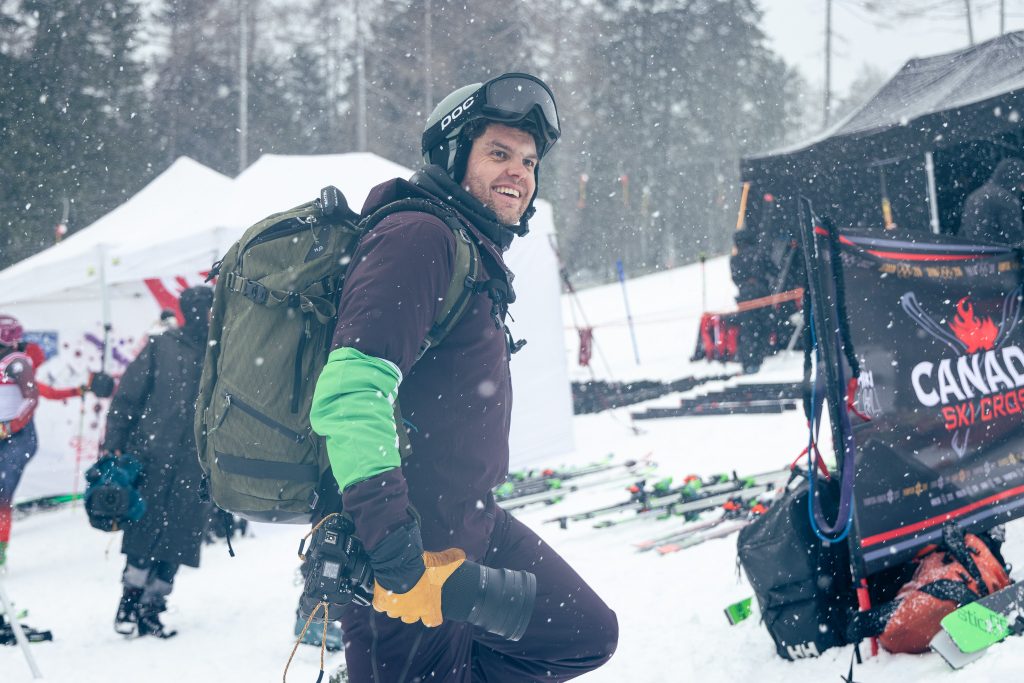
A Strategy for Every Shoot: Whether travelling by car or tackling unpredictable terrain on foot, Harald appreciates the versatility of his f-stop Camera Inserts. They allow him to switch lenses, gear and setups quickly, adapting to changing scenes and moments. This flexibility is crucial, especially when pre-event scouting isn't an option. He usually brings a second Camera Insert with him in the car filled with potential other lenses he might need. Depending on what the location offers, he has the option to adapt and get the best outcomes.
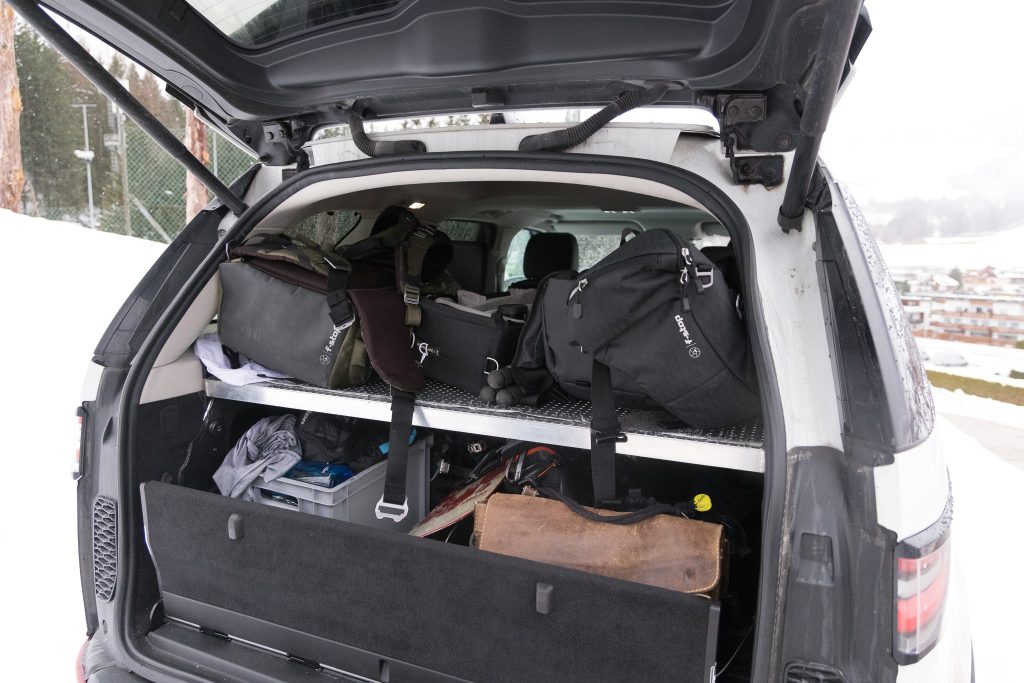
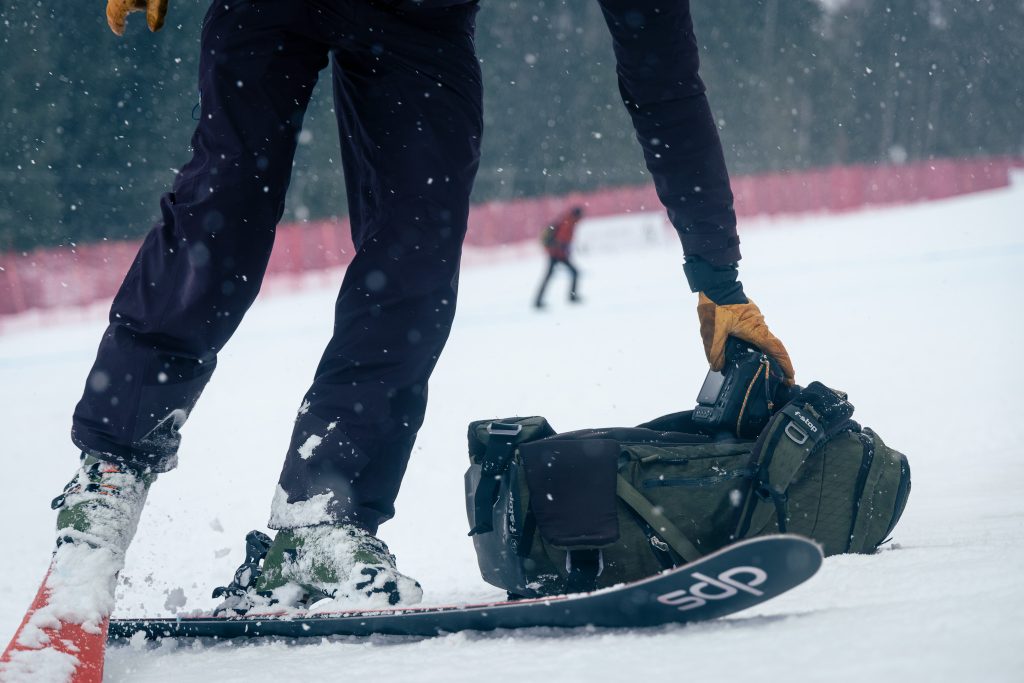
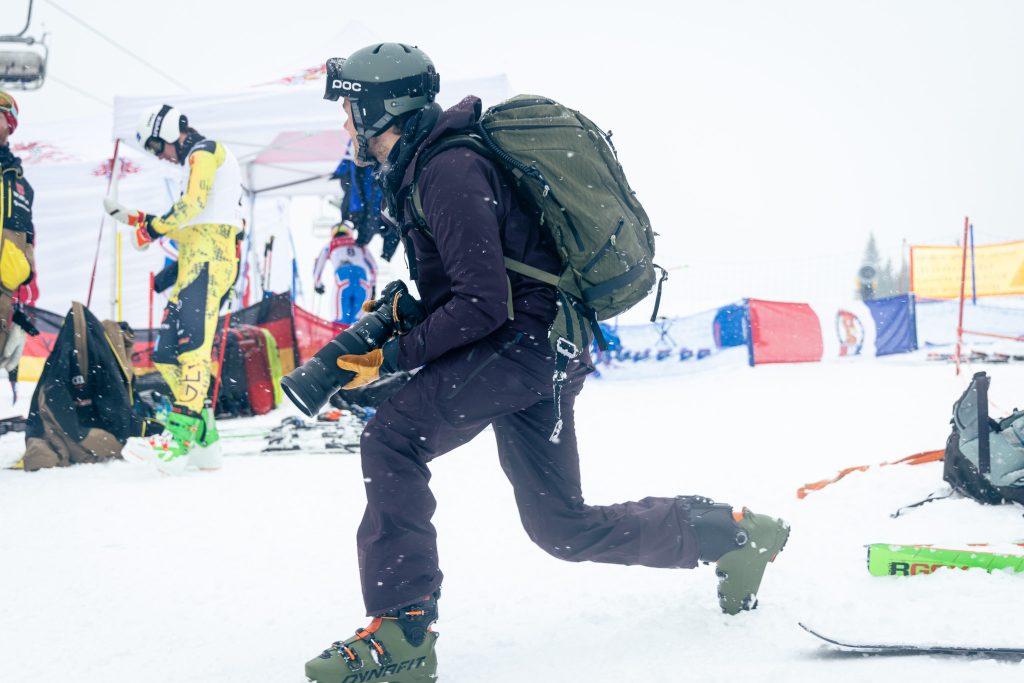
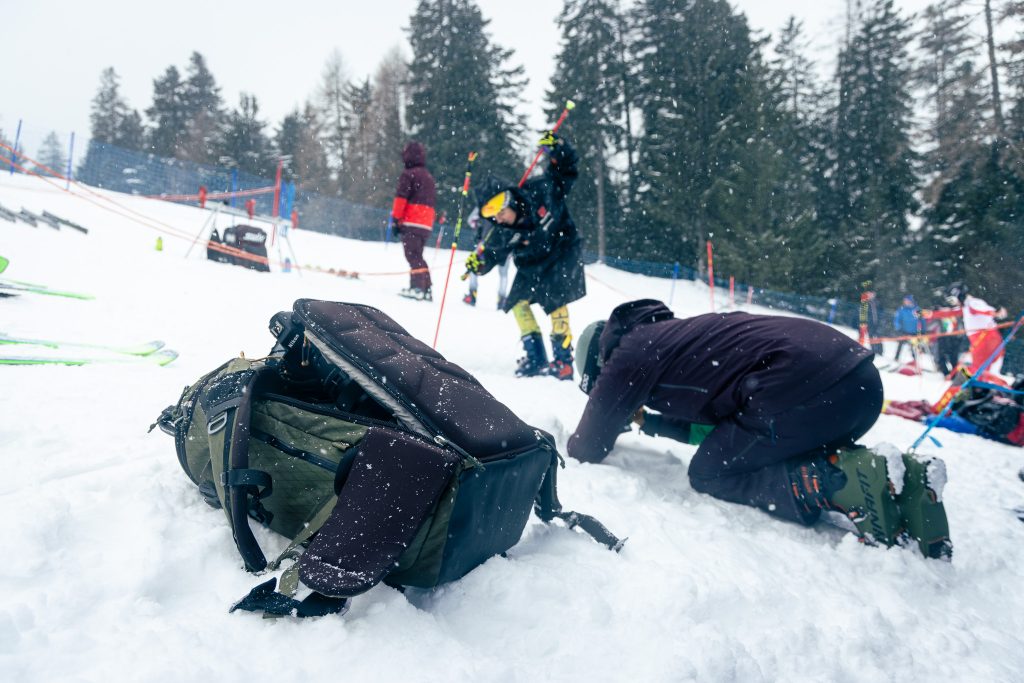
Harald utilizes a variety of equipment when he is out in the field. On this shoot he brought following gear with him:
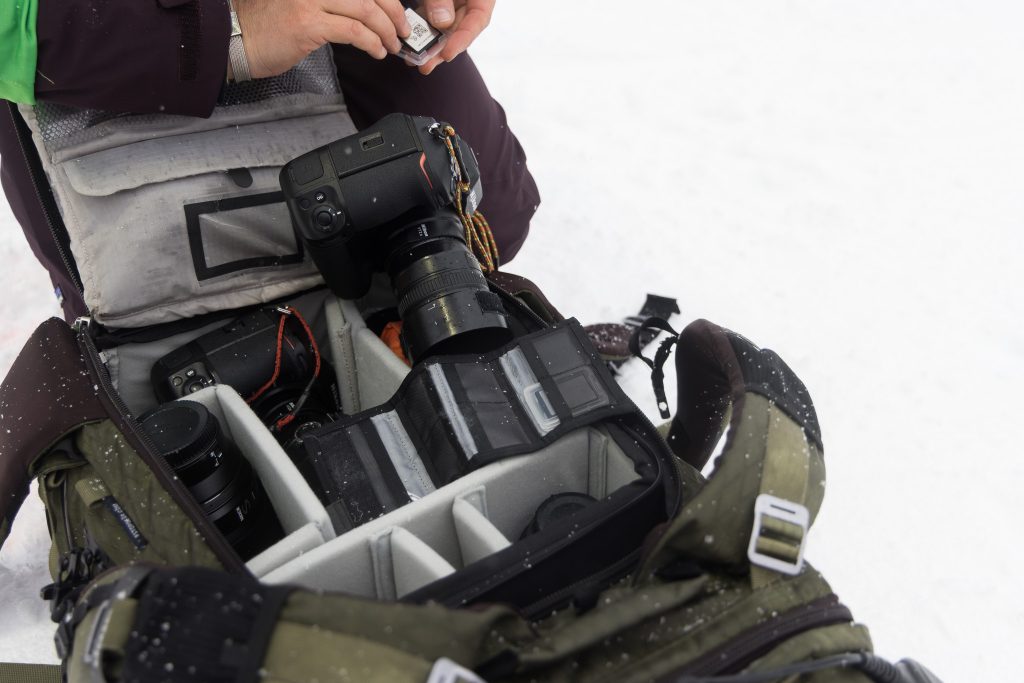
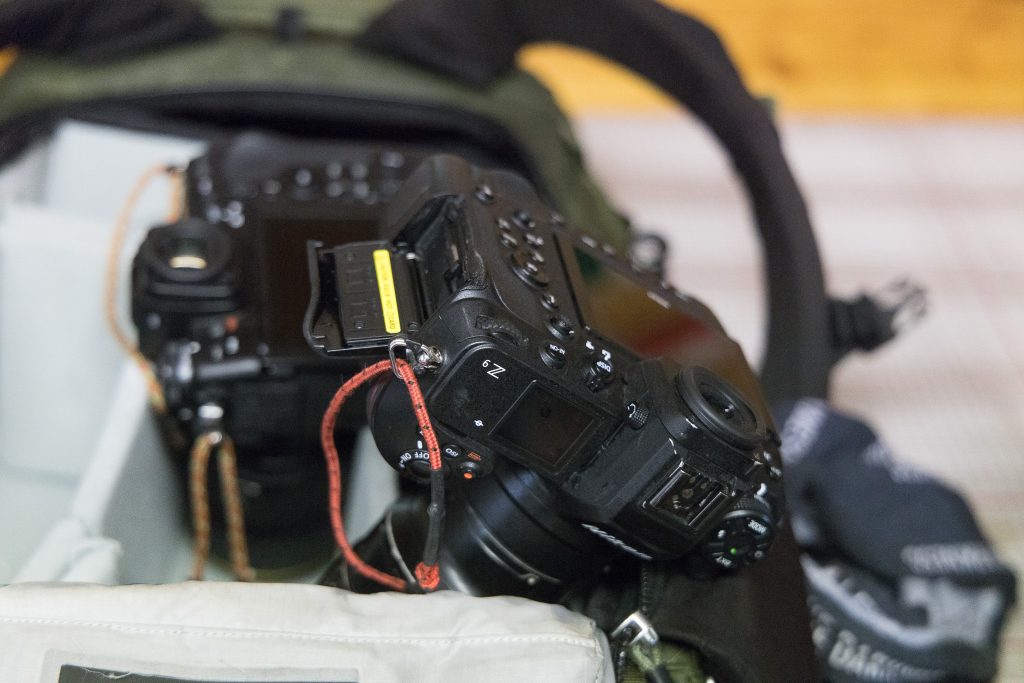
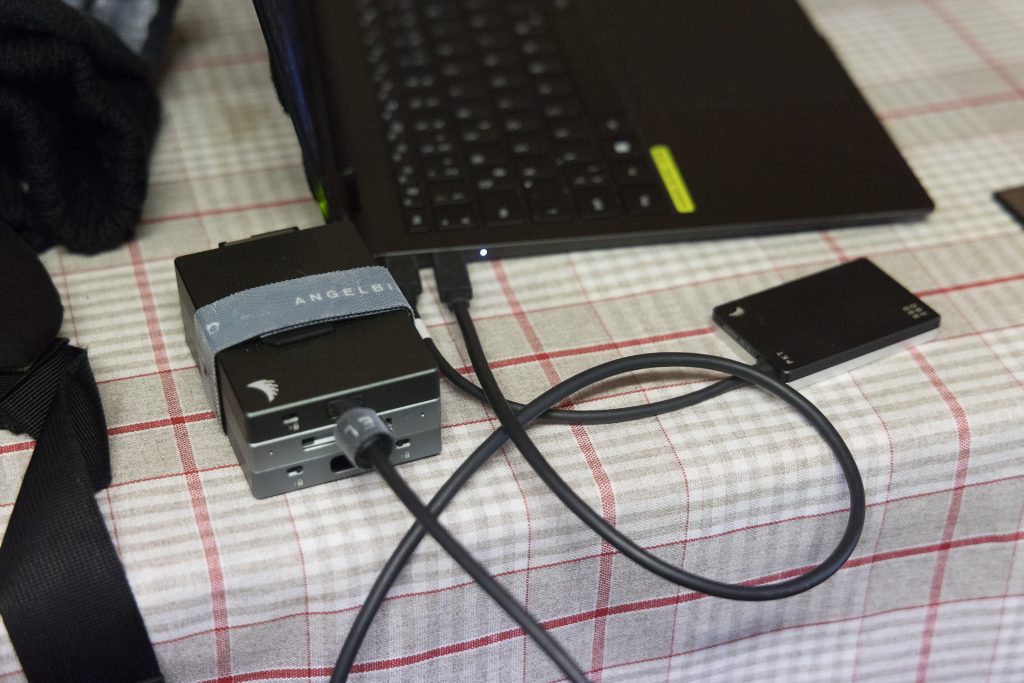
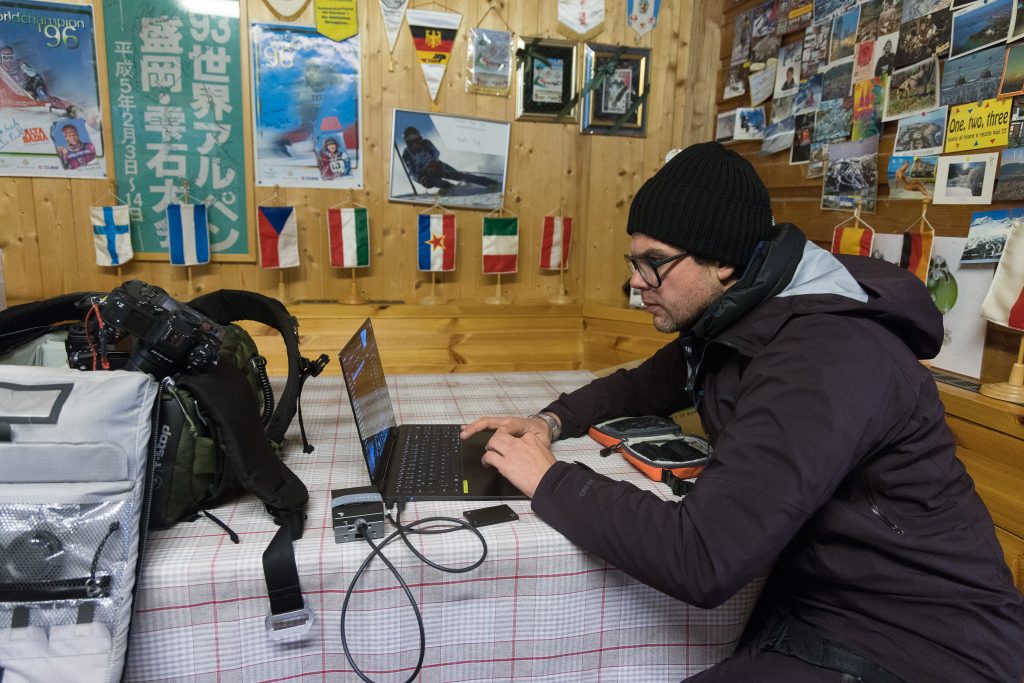
Learned Wisdom: The devil is in the details – or in this case, in the packing. Harald keeps his bag organized the same way regardless of the shoot, which makes adapting on the go a breeze. His approach is to make every slot and pocket useful to him! He also has a few more tricks up his sleeve. Also, he’s a firm believer in packing the little extras that you might not need. You never know when that ‘just in case’ item becomes a lifesaver.
On the final day, the weather closed in. Ineichen offers a stunning mountainous backdrop, but with snow coming in, Harald had to adjust his approach. Instead of isolating individual participants with his telephoto lenses, he adapted to shooting on a wider field of view. He then incorporated long exposure to highlight the dumping of snow and the speed of the race. Finding a darker background and panning his camera with the subject helped Harald make the most of the situation and produce his usual exceptional standard of work.
Harald Wisthaler
Stay flexible, stay responsive, and prepared to adapt at a moment's notice.

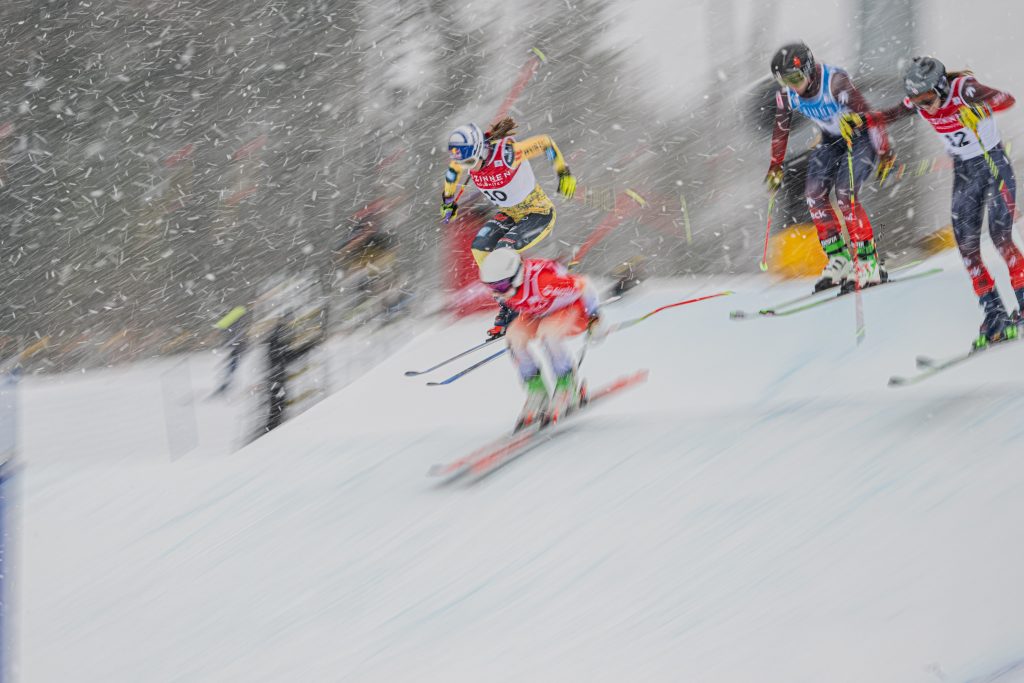

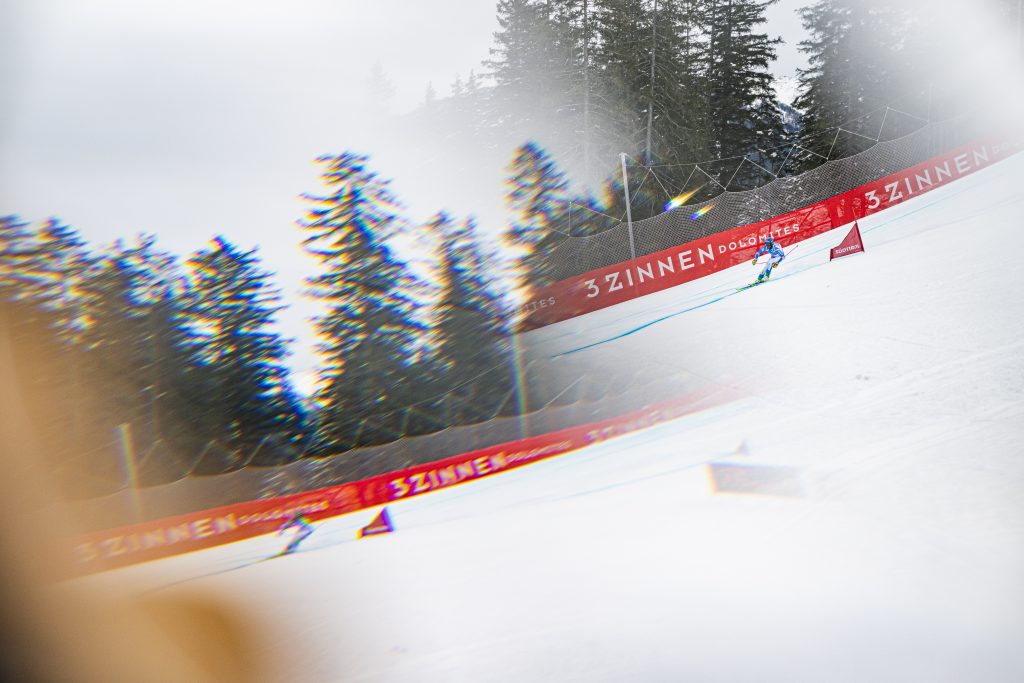
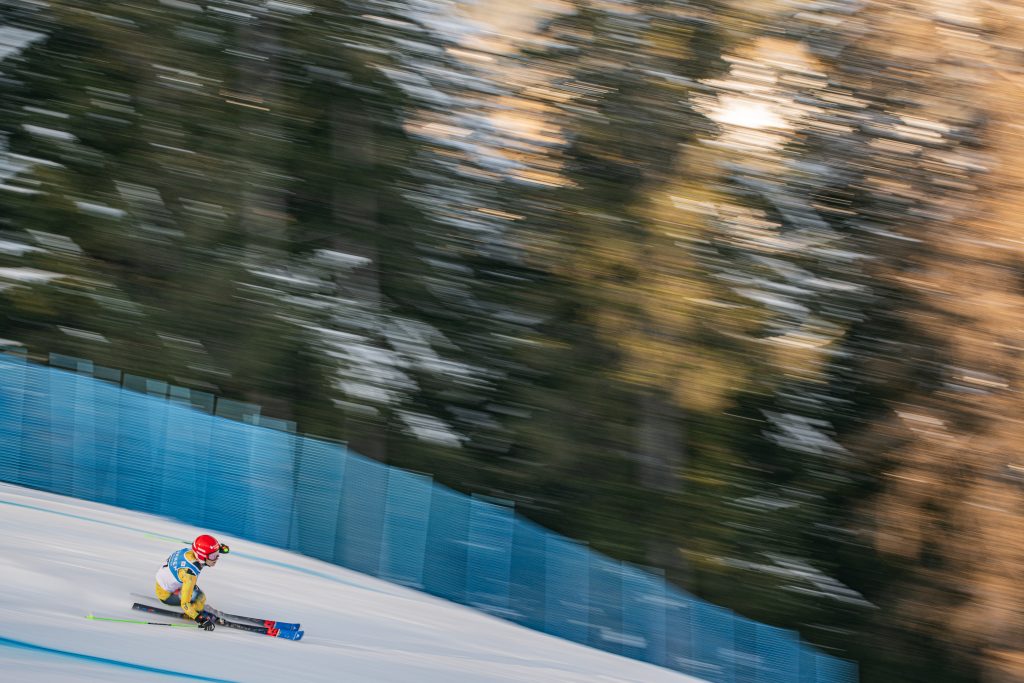
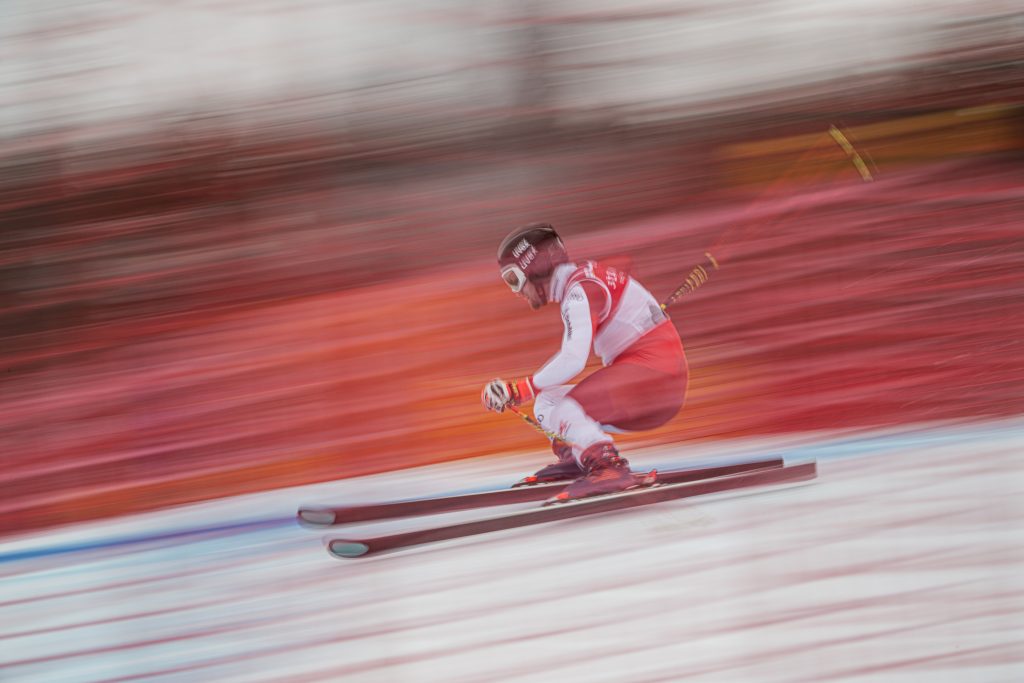


Discount Applied Successfully!
Your savings have been added to the cart.